
AT HOME in the Charter School kitchen SHARING A MEAL under the stars, Vineyard-style THE FISCHERS of Flat Point Farm NO. 50 HARVEST SEASON OUR FOOD, OUR STORIES, OUR COMMUNITY MEMBER OF EDIBLE COMMUNITIES
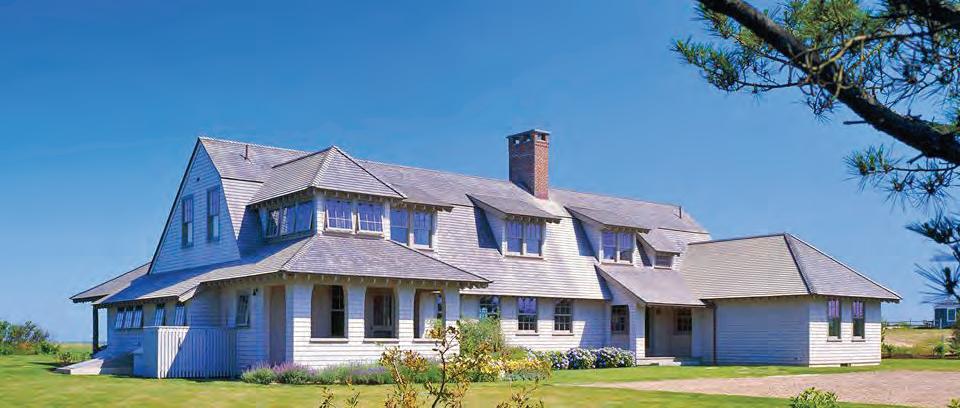










Doyle Construction Corp. Quality Home Building on Martha’s Vineyard 54 Hidden Village Road, West Tisbury, MA 02575 www.doyleconstructionmv.com • 508.693.9004 • bmazza@doyleconstructionmv.com
REAL ESTATE - MARTHA’S VINEYARD Beetlebung Corner, Chilmark 508-645-3533 www.conroymv.com Real Estate Services Island Wide We are celebrating 50 years in business
Experts in construction, renovations and restoration of high
quality homes
on Martha’s Vineyard since 1990.
LIGHTHOUSE ROAD, AQUINNAH



Waterview beach house in Aquinnah just a hop skip and a jump to the calm and sandy waters of the North Shore. Traditional layout with the kitchen, living, dining room and full bath on the first floor. The living room comes with water views and a cozy fireplace, and multiple sliding doors that walk out to the wrap around porch. Upstairs the views are increasingly beautiful! Four bedrooms share a full bath, one of the bedrooms has a fireplace while two have sliding doors that walk out to water view balconies. The full walkout basement/garage offers plenty of room for a vehicle, extra storage or to set up a ping pong table. This bright and airy home is the perfect Aquinnah retreat. Exclusively offered please inquire.
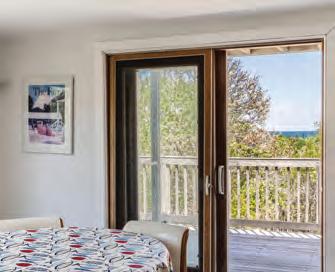
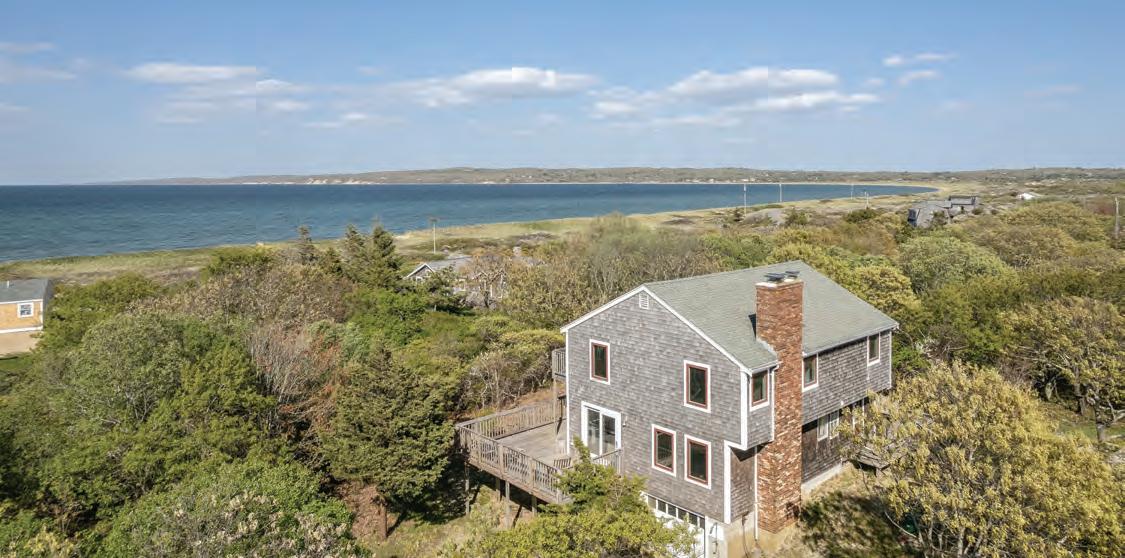

508.645.2628 Chilmark 508.696.9999 West Tisbury
Specializing in Choice Properties Since 1967 504 State Road, West Tisbury MA 02575 · Beetlebung Corner, Chilmark MA 02535 www.tealaneassociates.com

PUBLISHERS
Peter and Barbara Oberfest
EDITORS
Tina Miller and Connie Berry tina@mvtimes.com • connie@mvtimes.com
CREATIVE DIRECTOR
Kristófer Rabasca
PRODUCTION/DESIGN MANAGER

Dave Plath
EDIBLE VINEYARD MAGAZINE is published by The Martha’s Vineyard Times, publishers of The Martha’s Vineyard Times weekly newspaper, Vineyard Visitor, Martha’s Vineyard Arts & Ideas Magazine, The Minute daily newsletter, and the websites MVTimes.com, VineyardVisitor.com, and MVArtsandIdeas.com.
You can see the digital version of this magazine at ediblevineyard.com. EV is available at newsstands and select retail locations, free of charge. Find Edible Vineyard on Instagram and Facebook @ediblevineyard



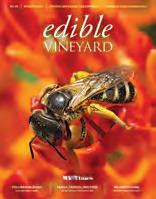
SUBSCRIBE
Please inquire at ediblevineyard@mvtimes.com about subscriptions by mail.


THE MARTHA’S VINEYARD TIMES
P.O. Box 518, 30 Beach Rd. Vineyard Haven, MA 02568
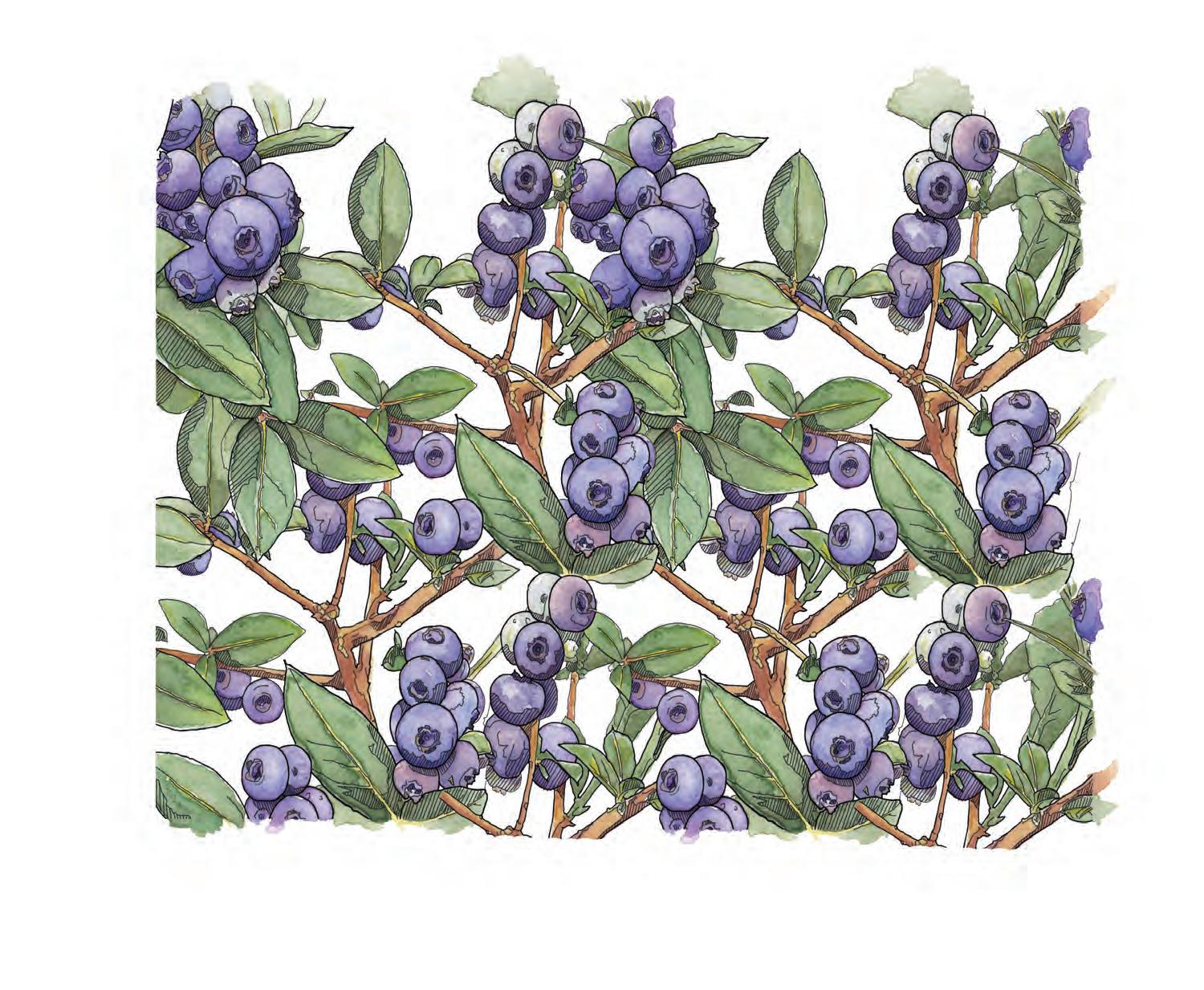
harvest season 2023 3
PLANT IT IN YOUR OWN BACKYARD www.vineyardgardens.net 48 4 STATE ROAD WEST TISBURY 508.693.8511 small fruits great time to plant FALL CROPS c ool weather VEGETABLES It’s the perfect gift! Edible Vineyard magazine delivered first-class four times a year directly to their (or your) door. Just $40 a year, subscriptions will start with the next printed issue. ediblevineyard@mvtimes.com
With UNCLE MIKE’S Herbs & Veggies you get quality, non-GMO plants that are selected for their ability to perform in our New England climate and are grown with Integrated Pest Managment (the good bugs eat the bad bugs) so you can feel good about growing organically at home.


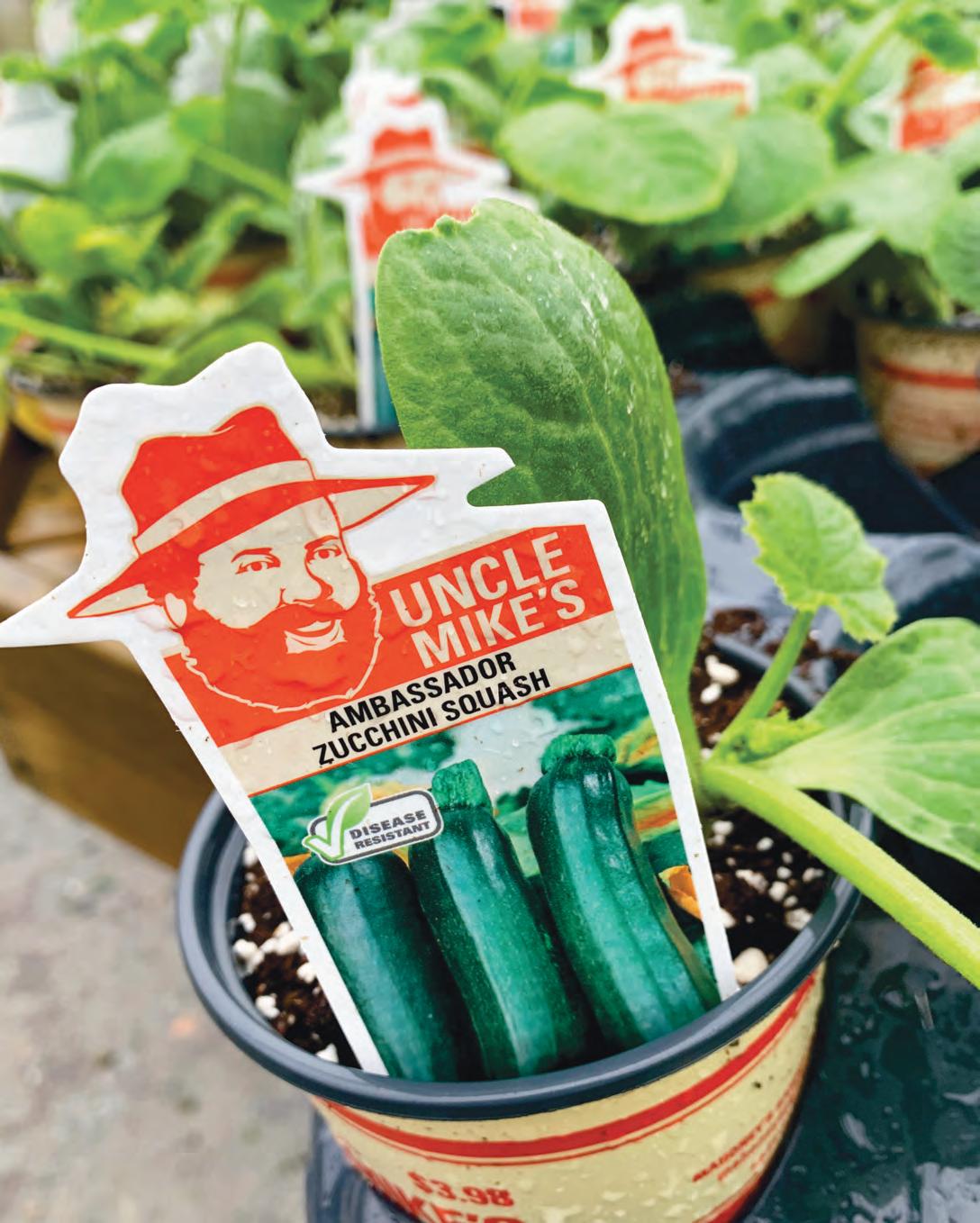
On Martha’s Vineyard Uncle MIke’s herbs & veggies are sold exclusively at Jardin Mahoney. 45 Edgartown Vineyard Haven Road Oak Bluffs - 508.693.3511 www.jardinmahoneymv.com Follow us @JardinMahoney
Feel good about the
you grow.
food
DISHING
8 Out & About Fresh culinary news from around the Island.
 By Maddy Alley
By Maddy Alley
FEATURES
1 2 C oming home
Why the Island’s Gen Zers stay to farm and fish.
By Tina Miller
20 Dinner f or eight
Homegrown dinner and conversation on the pond.
By Mollie Doyle
35 The Fis chers of Flat Point Farming stays in the family.
By Amelia Smith
ESSAY
2 4 A kid and his bucket Reminiscing about dining on the Vineyard in the 1950s.
By Geoff Currier
PHOTO ESSAY
26 Be asts of burden Draft horses are worker bees of the hooved variety.
By Sadie Dix
ON THE FARM
28 The r eturn of 4-H Learning and growing with with six very active clubs.
By Julie Scott
4 5 The Isl and’s newest star Lone star ticks and alpha-gal syndrome hits home.
By Kate Athearn
IN SEASON
40 C lassic codfish cakes
Whether a meal or appetizer, this seafood staple is just right.
By Tina Miller
IN THE KITCHEN
41 School l unch from scratch Betsy Carnie feeds students with sustainability in mind.
By Mollie Doyle
DONE!
48 R etirement? Not yet Steve Bernier keeps his connection at Cronig’s.
harvest season 2023 5 CONTENTS
Joanne Lambert
COVER IMAGE: Photographer Elizabeth Cecil’s photo of clams fresh off the grill at dinner on Chilmark Pond.





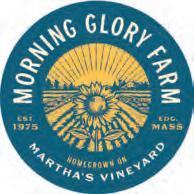





6 edible VINEYARD Now is the best time for lawn renovation, fall planting and fall cleanups! 508•693•8888 • CROSSLANDLANDSCAPE.COM Sustainable • Landscape Design • Site Planning Drawings • Stone Masonry • Lawn & Garden Maintenance • Excavation • Nursery Stock Permitting • Perennial Gardens • Sod MS Environmental Design, BS Plant and Soil Science. Massachusetts Certified. MA Certified Landscape Professionals, MA Certified Horticulturalists CR OSSLAND landscape Professional Landscape Services Est. 1975 Come experience the bounty We are now open year round Growing together with you, our community We’re Social! Follow us on Instagram @EDIBLEVINEYARD CHEESE B EEF PORK PANTRY EGGS RAW MILK BREAD PASTRY FARMSTAND OPEN 8 AM -6 PM — CLOSED TUES DA Y –THEGR E YBARNANDFARM. C OM FARM T OURS IN Q U I RE ABOUT FARM • GAR D EN CREAMER Y • BAKE RY
This time of year, the low sun sears through the windshield, blinding you for seconds with its golden glare. The outdoor shower is “refreshing,” and mornings are brisk. There is room on the road and no long lines to get a cup of coffee. For year-rounders, this is our time of year. We get to dance between corn and tomatoes and winter squash.
In this issue, we get one last lick of summer with a late-season dinner party on Chilmark Pond with old friends George Ahl and “Vineyard Folks” author Tamara Weiss. We are lucky to have the book’s photographer, Elizabeth Cecil, shoot this beautiful night, when the chill in the air started creeping in.
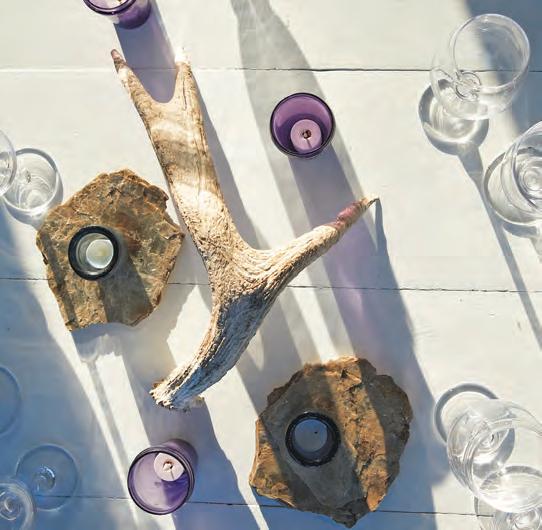


Staying with the pond theme, we head over to Flat Point Farm, owned by the Fischer family for decades. The Tisbury Great Pond surrounds open fields with grazing cows and sheep. Amelia Smith meets with farm matriarch Eleanor Nuebert (Fischer) and her nephew Mason and sees how they work together in sync.
Staying with farming, both land and sea, we are introduced to nine Gen Z Vineyarders who have chosen to stay and farm or fish here on the Island. They are essential workers and part of the Island culture we all love. These are motivated, passionate Gen Zers who love what they do. The question they all raise is where will they live?
We also get to step back in time with our good friend Geoff Currier as he reminisces about his summers growing up on the Vineyard. Geoff always makes us feel like we are right there with him in his stories.



Every time we put together an issue of Edible Vineyard, we realize how lucky we are to live in a community built on farming and fishing, which continues to thrive and feed us with great people, stories, and food. We are always surprised and grateful that we do not run out of things to write about on this small Island. The well is full.
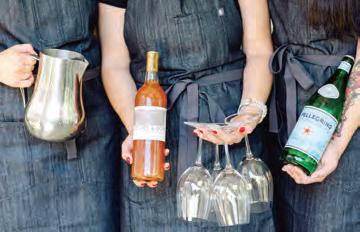

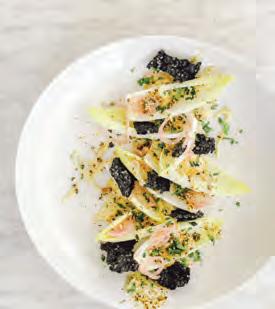
harvest season 2023 7
OPEN YEAR ROUND | 63 CIRCUT AVE. OAK BLUFFS, MA | 508-696-0200 | sweetlifemv.com
EDITORS’ LETTER
Elizabeth Cecil
About Out &
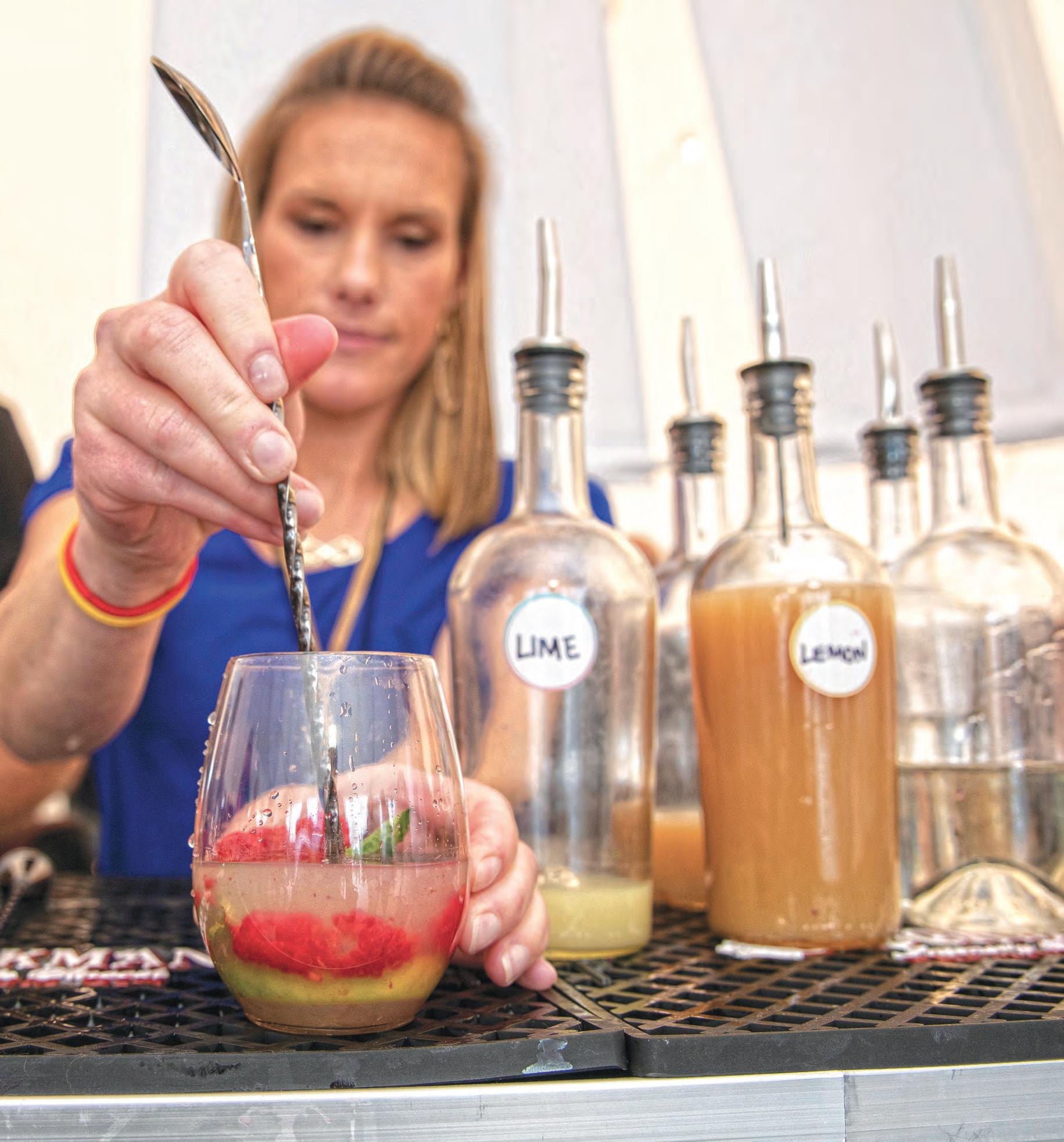
Who says there’s nothing to do around here in the fall and winter?
WORDS Maddy Alley
8 edible VINEYARD OUT & ABOUT
MV Times
The Brockman’s Gin booth at the M.V. Food and Wine Festival a few years ago.
Martha’s Vineyard Food and Wine Festival
Martha treats her occupants well, far beyond her namesake wine, with bountiful fruits, vegetables, seafood, meats, and dairy. The Martha’s Vineyard Food and Wine Festival, Oct. 19 to 22, will be a weekend your taste buds will never forget, granted you don’t overdo it on the wine. Seven tasting events, featuring local chefs and cuisine, will keep you full and may leave a few sheets to the wind on your sail home.

Harvest Festival
Not to be corny, but fall is the perfect time to harvest up some fun with local traditions, good food, live music, and games. On Oct. 21, the Martha’s Vineyard Agricultural Society will host its annual Harvest Festival. The event will include a pie-eating competition, pumpkin carving, a wild food challenge, a farmers market, music, and educational activities with local nonprofits.
Barn Raisers Ball
In 1994, a New Hampshire barn was disassembled and brought to the Island. Three hundred Island volunteers then pieced together the new Agricultural Hall in West Tisbury. After most of the work was done, local musicians Johnny Hoy and the Bluefish took to the dusty dirt floor, wood not yet laid, and jammed out while the barn raisers danced the night away. Every year, the Martha’s Vineyard Agricultural Society hosts the Barn Raisers Ball, a free community dance party to remember and celebrate everyone who helped. This year, on Nov. 4, Johnny Hoy and the Bluefish will play for everyone who wants to come party at the Agricultural Hall, toast to the Barn Raisers, and enjoy the dessert potluck.

Ghost Island Farm
You would think, given the name, Ghost Island Farm in West Tisbury wouldn’t need to dress up for Halloween. Think again. Farmer Rusty Gordon takes this holiday seriously, known to dress the farmstand up with, quite literally, to-die-for Halloween decorations. When questioned what
harvest season 2023 9
OUT & ABOUT
Harvest Festival
is a fun time for all.
Get down at the Barn Raisers Ball.
Jeremy Driesen
Dena Porter
2023 will bring, the mysterious man used the words “big,” “fabulous,” and “magnificent” but gave no hints to what we can expect to see this October.
The Farm Institute
As summer ends and autumn begins, sand is vacuumed out of cars, boogie boards are stored away, and kissing the sun goodbye can make you feel like breaking down. The Farm Institute, in partnership with the Martha’s Vineyard Agricultural Society, is harnessing the energy of this breakdown with their fall Butchery Basics series, including hog and deer breakdown workshops.
Chef Look Cooks
It is looking like cooking season, and Chef Look Cooks is back at the Edgartown library with monthly cooking classes. The fall’s classes will all focus on better batters. The October class will be on waffles, November will focus on crepes, and December on cornbread. The classes are free to hungry students, but pre-registration is required.
The Pawnee House
The Pawnee House, a location cornered in history between the original 1872 Pawnee House Hotel and the first 1930 location of Giordano’s in Oak Bluffs, is now a contemporary comfort food restaurant. This fall, the restaurant will
serve food and entertainment all day long, with the return of brunch, movie nights, and pop-ups with Island chefs. The menu, which maintains many vegan options, will shift focus to fall dishes, including vegan harvest savory pot pie.

Thanksgiving Meals
There is so much to be thankful for on this beautiful Island, and not having to cook is one of them! After a summer you could spend eating somewhere different every night, Island restaurants and farms are here to help provide Thanksgiving meals. Morning Glory Farm, Katama General Store, Little House Cafe, Scottish Bakehouse, and Black Sheep all have full Thanksgiving takeaway menus, including turkeys, stuffing, sides, and desserts. The Grey Barn and the Larder will have pre-sale opportunities for baked goods and other sides. Beetlebung Farm and North Tabor Farm will sell turkeys, but early pre-order is suggested before the farms run out (the turkeys won’t be running anywhere).
Pumpkin Festival
If you can carve away some time on Oct. 14, Morning Glory Farm hosts its annual Pumpkin Festival. The smashing event should get you pumped up for Halloween with pumpkin painting and carving, hayrides, cider pressing, pumpkin bowling, petting pens, haunted potting shed and hay mazes, face painting, photo booths, tie dyeing, and live music.
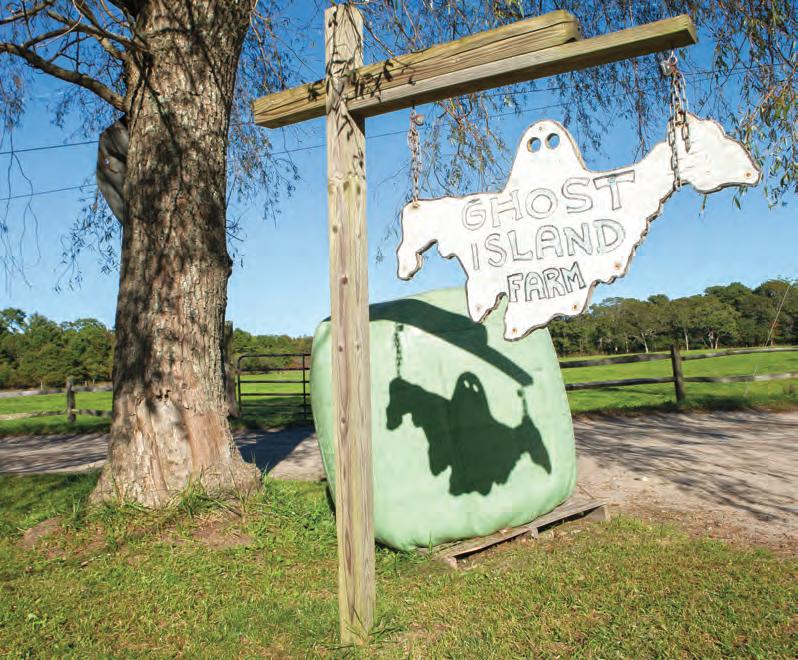
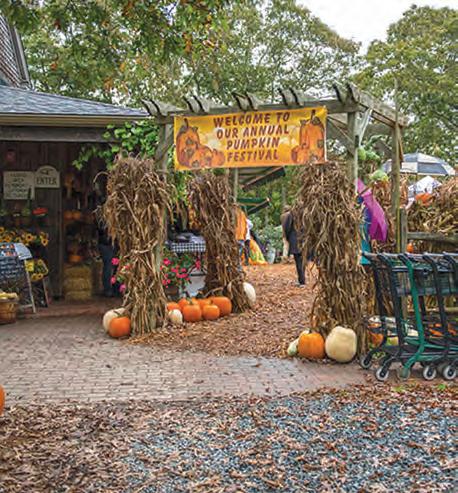
10 edible VINEYARD
Savory pot pie served at Pawnee House.
OUT & ABOUT
Morning Glory Farm’s annual Pumpkin Festival.
Ghost Island Farm gets spooky in the off-season.
Photos: MV Times
Bad Martha Farmer’s Brewery

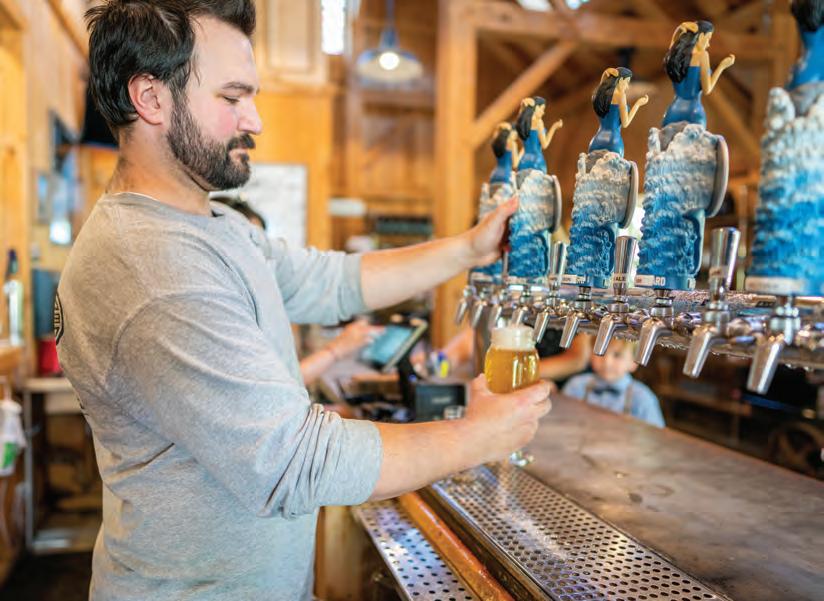
Bad Martha Farmer’s Brewery is doing good by Martha’s Vineyard this fall with a schedule packed full of events for the whole family. Throughout the fall, brainiacs can enjoy trivia nights, athletes can enjoy Amity Island Run Club meetings, and we can all enjoy live music. Special weekend events will pop up too, including an Oktoberfest celebration, a pumpkin carving weekend, and a holiday gift market.
Seed Processing and Swap




Autumn is the perfect time to lay the groundwork and sow the seeds for beautiful buds to come. The West Tisbury library has events through the winter and spring to sprout some ideas for your gardens. The Fall Seed Processing Workshop offers an opportunity to save seeds, and the Winter Seed Swap and Spring Seedling Swap offer a chance to share your garden treasures.
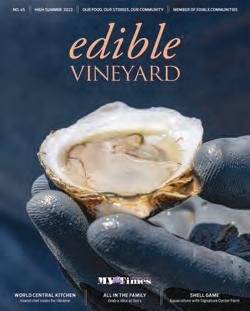
harvest season 2023 11
PUBLISHING 4 TIMES A YEAR To advertise call 508-693-6100 or email adsales@mvtimes.com. Scan to read online ediblevineyard.com
Cal Scarfone pulling a beer at Bad Martha Brewery.
OUT & ABOUT
Jeremy Driesen
Growing up on the Island, I felt the urgency to leave and get out into the world, a common theme for many kids in any hometown as they approach the end of high school. To head out to college, travel, or just try something new. The Vineyard brings an even stronger urge to leave because we are on an Island. When visitors find out I was born and raised here, there is often a look of shock and disbelief as if how could that be? Are there schools, hospitals, what’s open in the winter? How do you leave, do you leave? People forget there is a consistent year-round community that lives and works, keeping the engines going and lights on.
The Island will always have a call for young people to stay in the community. I spent most of my career in the food business, and I now work in real estate. I have a son who is a regenerative farmer on the Island.
I have had a curious, perhaps magnified, look at where we are with the younger generation. For this article, we focused on young adults raised on the Island — Gen Zers, born after 1997, who have chosen to stay and farm or fish. Some of this group grew up in the family business they now work in. Others fell in love with their chosen industry at a young age.
Tom Osmers, a legend in the fishing community for his environmentalist advocacy for sustainable oyster farming and fishing, was a generous spirit and a great influence on Otto. He spent his high school years working in Menemsha on fishing boats and at the Fish House, a seafood wholesaler that closed in 2020 and is now the Martha’s Vineyard Seafood Collaborative. Otto owned his first boat at 15 or 16 he says, and has owned five boats already — sold two, has two for sale. His main boat now is the Right Stuff, which he bought as a “good deal” from a retiring fisherman.
When did you figure out fishing was what you wanted to do?
I did a year at college and came back when my grades were really bad. I was always talking to my buddies back home who were fishing or scalloping. I just think I kind of knew pretty quick school wasn’t for me. I started scalloping that summer with a friend and I never went back to school.
Coming Home
They all have a strong love of this community, determination, gratitude, focus, and optimism. Housing was certainly front and center; I found it unusual for such a young group to have that much awareness and understanding of the challenges of creating a life on the Island. That said, they are forging ahead, dreams in hand.
Editor’s note: I did not interview my farmer son; Mollie Doyle pitched in to get an unfiltered point of view.
OTTO OSMERS
Otto is a 23-year-old commercial fisherman, fishing for black bass, conch, and scalloping out of Menemsha. The morning I met up with Otto, it was pea-soup thick fog, and he was just coming in with some black sea bass, as the season quota is nearly met. Otto’s uncle,
What do you love about your life here and your work?
It’s a lot of fun. I mean, it’s hard but it can be really rewarding and really tough. Rewarding economically and mentally — when you have a good day it’s always great. Everyone’s catching. It’s like there’s no better feeling when the pots are full. That’s definitely the best feeling ever. Or when you’re scalloping offshore and coming in after like a week or two-week trip — that’s always rewarding, that’s always great.
What challenges do you see for the Island?
Definitely living costs.
I’m lucky. On my family property, I’m building a house right now, a detached bedroom. So I’m really lucky to have that, to be able to do that. But I mean, that’s not cheap either. But definitely, housing is really hard here, and the cost of living too. So it’s definitely hard, getting gear or getting bait can be challenging. You’re isolated here, and there’s only a fixed number of houses here and they’re all getting bought up. So I mean, housing is obviously what is really hard. So I don’t know what’s going to happen, because there is a huge wealth divide, everything’s getting bought up.
Where do you see yourself in 10 years, your industry?
You know, doing the same thing. Every year is different, there is a lot of bouncing around. Last winter, I did some carpentry and scalloping. I like to stay busy, whatever it takes.
12 edible VINEYARD
The Island’s next generation talks about struggles, dreams, and why they stay on the Island.
FEATURE Coming Home
WORDS AND IMAGES Tina Miller

Coming Home FEATURE
You’re isolated here, and there’s only a fixed number of houses here and they’re all getting bought up.
– Otto Osmers
harvest season 2023 13
Otto Osmers with his fresh, trapped black bass.
MATTEUS SCHEFFER
Matteus Scheffer is a 23-year-old commercial fisherman and oyster farmer at Little Minnow Oyster Co. out of Edgartown with his grandfather, Roy Scheffer. Roy was one of the original oyster farmers with Jack Blake on Katama Bay who, over the decades, have supported and taught new generations of oyster farmers, helping create a sustainable, supportive, thriving aquaculture future. Matteus’ great uncle Louis Larsen sold a scallop boat to him and his partner, Grace Kenney. They named it Anita Penny, after their two grandmothers. Do you hear the pun in Anita Penny?

When did you know you wanted to stay here?
I graduated from the University of Rhode Island, where I studied and got a degree in aquaculture and fisheries sciences. And then I came back here and started fishing. My whole family is here and growing up on the Island, this is the place I want to be because this is home, and everything that I want to do is probably here.
When did you figure out shellfishing and oyster farming was what you wanted to do?
My grandfather asked me to work for him my senior year in high school, and I had a general idea because I grew up with my dad out of Menemsha Pond; he was the shellfish constable. I just spent days with him because they didn’t bring me to summer camp. I just spent a lot of days on and in the water and kind of fell in love with it.
What do you love about your life here and your work?
I can kind of make a living being out in the water every day, shellfishing or oyster farming. Providing food for people on the Island is something that I’ve taken to be super special now. And it’s really hard work. I love being in the water and working hard, and some days are really good and some days are really not good. And just the sense of community. I mean, I’ve had so many people help me get started, buying the first boat that I’ve been shellfishing on and helping me with certain rakes and equipment you need to catch quahogs and bay scallops, and just the community here is amazing for that. And there’s people out here that really want you to succeed and make it, and I think that’s great.
What challenges do you see for the Island?
Challenges? Definitely housing. I just know so many kids my age that are just really trying to get out of their parents’ houses because to be honest, like when you’re 23, it’s hard. You can have a great relationship with your parents and whatever, but you want to do your own thing. You want to have your own space, and unfortunately, space is getting really limited on the Island.
Where do you see yourself in 10 years, your industry? Your hopes. Well, in years, hopefully, I’ll expand my fishing operation. I’d love shellfishing, but I also would love to expand and to get a bigger boat, maybe some bigger Massachusetts state permits. To be able to make more money, maybe afford a house one day,
14 edible VINEYARD FEATURE Coming Home
Matteus Scheffer at Katama Bay.
My whole family is here and growing up on the Island, this is the place I want to be because this is home, and everything that I want to do is probably here.
– Matteus Scheffer
I hope. Within 10 years, I’d be able to have a house and be living here and not be super tight on money.
ASTRID TILTON
Astrid is 25 years old and has hit her stride as the gleaning manager at Island Grown Initiative. Astrid graduated from Hampshire College, where she studied photography. The day I met with Astrid at IGI, they had gleaned 850 pounds of eggplant donated from Morning Glory Farm, which will feed Islanders. Astrid’s roots run deep on the Island; the Tiltons were some of the earliest European settlers going back to the 1600s.
When did you know you wanted to stay here?
COVID made it a pretty easy choice to come back here after school, but I also didn’t have any other plans. I wasn’t always set on coming back here, but I also couldn’t think of another place that I would really want to go. I just knew that IGI would hire me after school and I really liked living on the Island, so that seemed like a good option to me. And every year I’ve continued enjoying living here so I just kept doing it.
When did you figure out farming at IGI was what you wanted to do? I do credit a lot to the Charter School through their mentorship program, especially since I had both a photography mentor,

David Welch, and then with Noli (Noli Taylor, senior director of programs at IGI), and both of those things felt really good to me. So, I chose to go to Hampshire. I found that working with the natural world allows me to use a lot of the same skills as photography. And I approach my life practice of being a young gleaning manager like an art practice.
What do you love about your life here and your work?
I was thinking about this a lot. In my daily life everything feels really pleasant to me. And it’s just like, everything’s pretty beautiful. I like my drive to work. I like being here. After work, I like to go to the beach. I am so connected to the ocean of course. And I like the pace of life. Yeah, it’s a little slow, which I really don’t mind. I like to be kind of thoughtful and slow in the winter. And then I like a little drama in the summer.
What challenges do you see for the Island?
Yeah, housing, of course. Yes. Housing troubles. When I first moved back here, I was more depressed about it because it just seems kind of overwhelming. It was kind of daunting, the amount of money that I will have to make. To make my first million, ha!, but yeah, honestly, I’m feeling okay, now that if I really want to live here, I can make it happen, I can make it work. But then the idea that it is really hard for other people, and having my friends move away. And I wonder, is it going
Coming Home FEATURE
Astrid Tilton is the gleaning manager at Island Grown Initiative.
I like the pace of life. Yeah, it’s a little slow, which I really don’t mind. I like to be kind of thoughtful and slow in the winter. And then I like a little drama in the summer.
– Astrid Tilton
to be really lonely here In a few years? I found an apartment, which is shocking, but it’s a nice, private place. It took a while to do that.
Where do you see yourself in 10 years, your industry?
Well, actually, in 10 years, probably back here. But I do think of moving off the Island. I just visited some friends who moved off-Island and it’s interesting. They had a beautiful life here and now they have a beautiful life where they moved, but it doesn’t mean everything’s easier. So it’s definitely like a trade-off. It’s like if housing was easier someplace else, other things could be more difficult. It’s kind of nice for me to see the grass is not greener.
CHRIS MAYHEW
Chris Mayhew is 24 years old and is a commercial lobsterman out of Menemsha. Chris’s boat, Solitude, is docked in Menemsha Harbor next to his father, Jonathan Mayhew’s, boat, Skillie. Chris graduated from the University of Rhode Island with a degree in aquaculture and fisheries science. He comes from a long line of fishermen. His father owned the Quitsa Strider ll, and his Uncle Greg and his grandfather were also fishermen.

When did you figure out commercial fishing, lobstering was what you wanted to do?
For my whole life, my dad has shared a dock with Pat Jenkinson.
One day, Pat hung a for-sale sign on his boat, Solitude. That’s when I knew I wanted to do this. Getting into commercial fisheries is extremely difficult. It seemed overwhelming. Pat was ready to retire from lobstering but wanted to keep his license local in Menemsha, going to someone on the Island. I got really lucky. There are not many opportunities to get the permits, it is rare for them to become available — and costly. It’s just hard to break into the fisheries industry. Pat has been really helpful, like a mentor, always able to help out when I have questions.
What do you love about your life here and your work?
Well, you can’t not love being on the water. Sometimes, [I think] is this really my job? The weather isn’t always great, but at the end of the day, I am lucky, and I like being my own boss. I determine my schedule, and you really get out what you put in. There are times when you don’t make anything, and then you have a great month. July is the best month for lobstering, and everyone knows it. They say everyone catches lobster in July and then you go to work.
What challenges do you see for the Island?
Housing! The housing market is insane right now. I do not see owning a home anytime soon. I am lucky that my family has been around a long time, so there are family places to stay. I am grateful. But it will not last forever, as the generations go forward properties get sold.
16 edible VINEYARD
Chris Mayhew, on his lobster boat in Menemsha.
I do not see owning a home anytime soon. I am lucky that my family has been around a long time, so there are family places to stay.
– Chris Mayhew
Where do you see yourself in 10 years, your industry? Your hopes. I hope to build on this. I am also looking to buy a conch permit to fish year-round. I also need a new engine eventually, so I will work towards that for now. Eventually, start saving for a home.
RUBY DIX
Ruby is 25 years old and earned a degree in food studies at Bennington College in Vermont. Ruby grew up farming on her family farm, North Tabor Farm in Chilmark. Her parents, Rebecca Miller and Matthew Dix, started the farm back in the mid-1990s, growing everything —beautiful salad greens, tomatoes, arugula, melons, potatoes, you name it! Luckily for the farm, Ruby has stepped into a natural progression, the next generation at North Tabor Farm.

When did you know you wanted to stay here?
My junior year of college. Whenever COVID kind of started, I went online and then I had the option of going back to school in person. My major was food studies and it just didn’t make sense; I’m doing my major, food studies, on the Vineyard by working here. So I was just like, I’m just going stay here and see what happens.
When did you figure out farming was what you wanted to do?
I think I’ve been managing the farm since I was 18, but it was
very seasonal. I’d come in when I got out of school and I’d manage for a season, and then I’d have to go back to school, so probably my first full season that I got to be here. The whole time with a crew was when I was like, oh, I want to do this because I got to have the full experience and I still enjoyed it. I wasn’t bored or worn out by the end of it. And so I was like, I think this is what I want to do.
What do you love about your life here and your work?
I just like to be able to do a lot of different things in a day. I don’t think a lot of jobs that are outside allow you to do 10 different things from seeding to harvesting, to planting to doing the Farmers Market. It’s just nice to keep moving and doing all different things. My farm is small enough that I never spend one day doing one thing. There’s at least five things on our list every day.
What challenges do you see for the Island?
I think the obvious one is housing. I live on the farm in the summer and then I have a winter rental down the road in Chilmark. I’m just ready to have my own space and accumulate stuff. I’ve never owned furniture or decorated a space. My parents are building a year-round, two-bedroom apartment. It’s lovely and it’s going to be farmer housing and I’m sure I’ll be staying in it
Continued on page 30
Coming Home FEATURE
My farm is small enough that I never spend one day doing one thing. There's at least five things on our list every day.
– Ruby Dix
Ruby Dix, farm manager at North Tabor Farm.
harvest season 2023 17





Sponsored by Cronig’s Markets and Healthy Additions
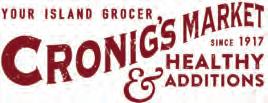
Super Soup
Serves 4-6
¼ cup extra virgin olive oil
11 to 16 oz. chicken sausage, or whatever sausage you prefer, halved and sliced
1 medium onion, diced
3 cups carrots, sliced
2 cups celery, sliced
1 cup leeks, rinsed, halved, and sliced (white part only)
5 cloves garlic, minced
1 cup Italian parsley leaves, rinsed, dried, and chopped
2 Tbsp. fresh rosemary, chopped
2 Tbsp. tomato paste or
¼ cup tomato sauce
Dark leafy greens such as kale, chard, or collard greens, rough chop
(Rinse and remove the spine if kale is used)
3 cans combination of chickpeas and northern white beans, drained and rinsed
3 quarts chicken broth
Salt and pepper to taste
Soup with purpose
This time of year, nothing is better than a big pot of simmering soup on the stove, filling the house with warmth. Why not make it delicious and healthy?

There are a lot of food fads out
there, but this soup is a Super Soup, made with straight-up whole, fresh, nutrient-rich ingredients, all with purpose. Cronig’s has all your ingredients in one stop. Using chicken sausage keeps it lighter, but Cronig’s Market has plenty of options. Feel free to top it with fresh grated Parmesan cheese. This soup doesn’t need to sit on the stove all day; it comes together quickly, but like most soups, it’s even better the next day.
In a large, heavy soup pot, heat olive oil on medium-high heat. Add chicken sausage and sauté until slightly browned. Add onion, carrots, celery, garlic, and leeks. Combine, being sure not to brown veggies, and lower heat. Cook for several minutes. Turn the heat back up and add fresh herbs. Combine and cook for about 5 minutes. Stir in tomato paste, then add the chicken broth. Heat on medium-high. Add chopped greens. Cook on medium-high heat for about 20 minutes, until the greens soften. Add drained beans, combine, and cover the pot, leaving the lid askew so it is not tightly covered. Turn down to simmer and cook for at least one hour or more. Soup is always better on day two.
This story and recipe was brought to you by:
harvest season 2023 19
A nutrient-dense soup to warm up the kitchen on these cooler days.
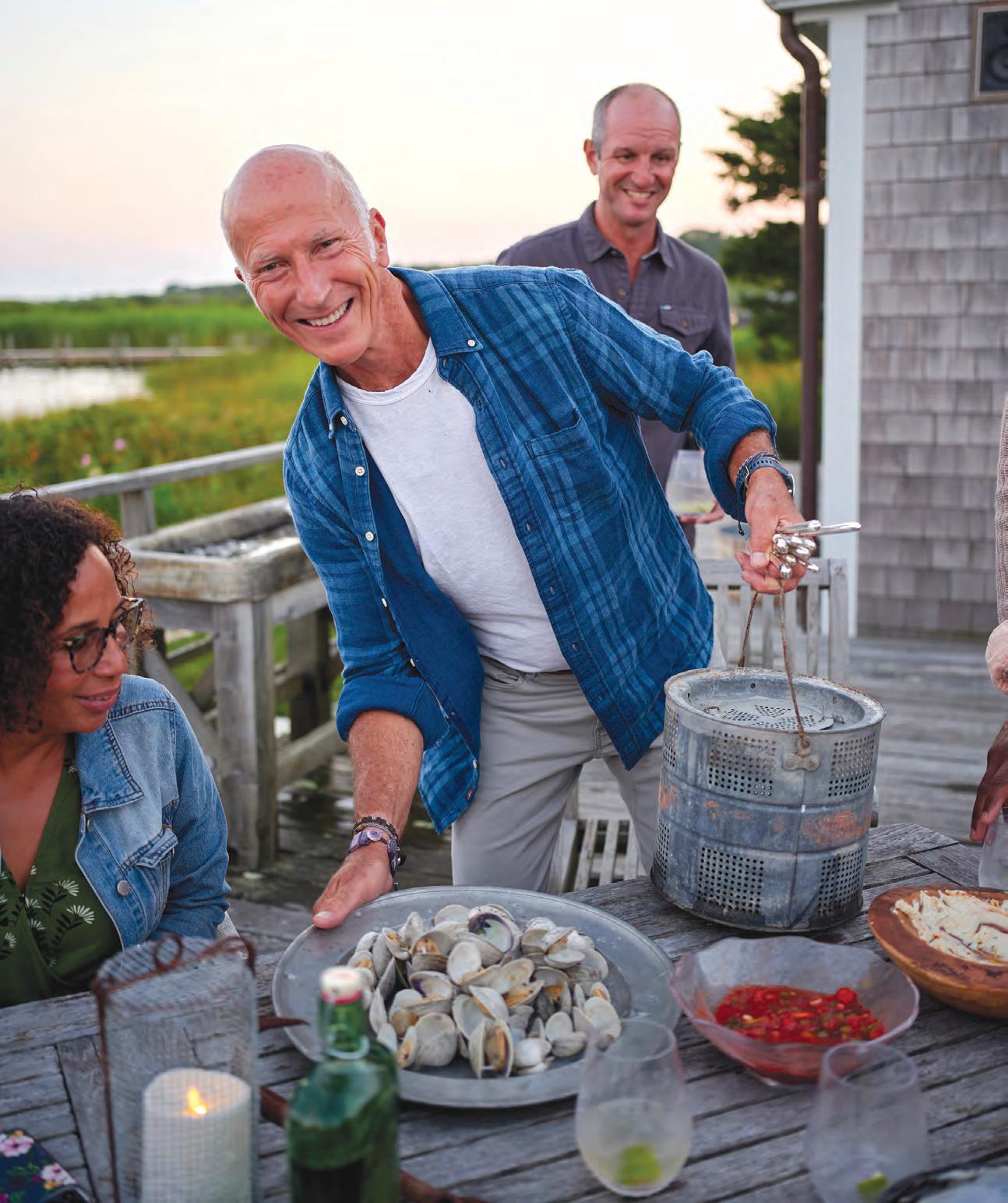
20 edible VINEYARD FEATURE Eating with Vineyard folk
George is serving up steamed littleneck clams.
One of the greatest traditions of Martha’s Vineyard’s food culture and community is the fact that we eat in. Sure, there are great restaurants on the Island, but the ultimate Vineyard meal happens at a friend’s table, eating food grown and foraged from here.
In recent years, George Ahl’s meals at his home on Chilmark Pond have become one of the many hot spots for this kind of evening. And Edible Vineyard was lucky enough to be extended an invitation.
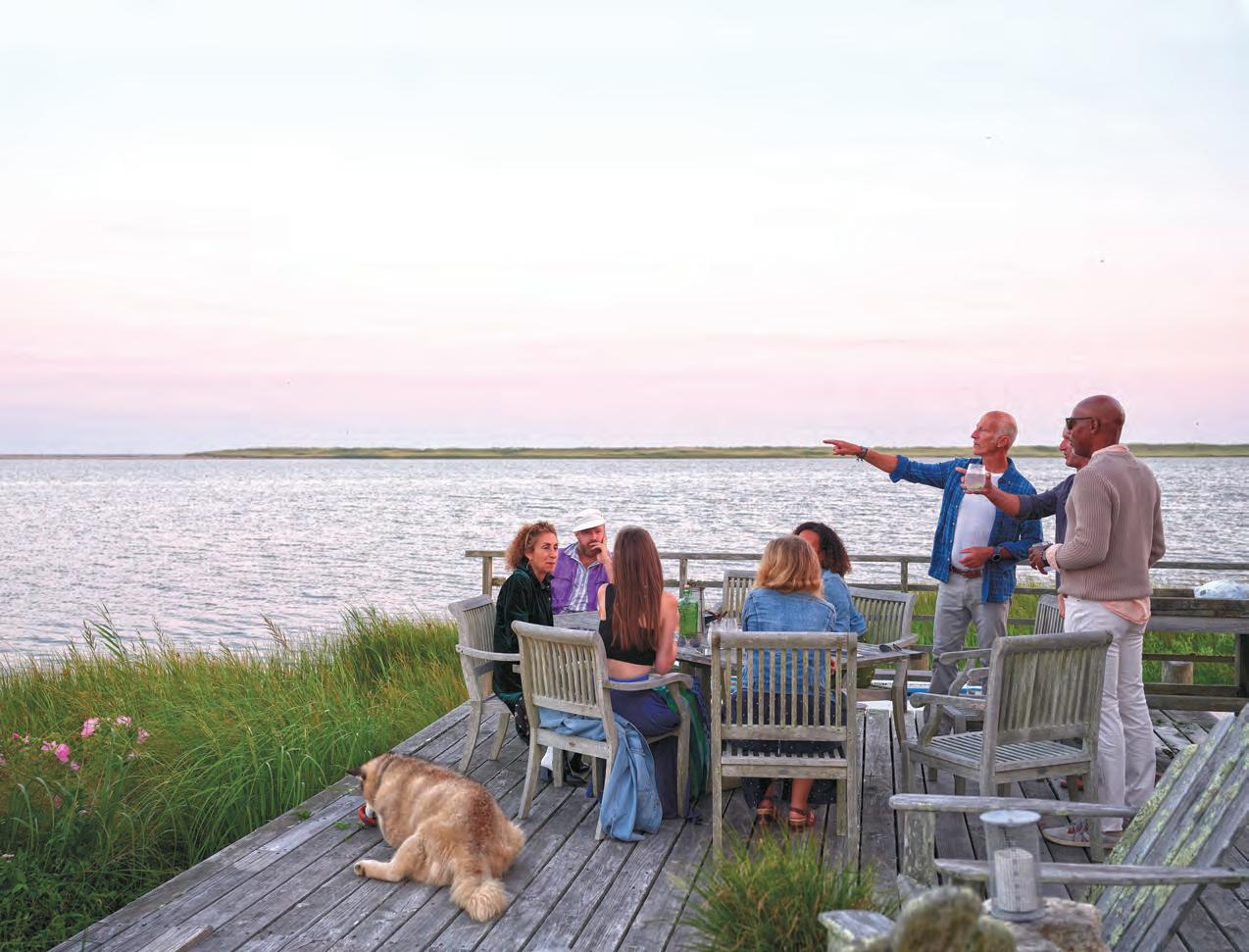
The menu:
• Lemon Hummus
• Tomato Salsa with Grilled Milkweed
Farm Peppers
• Grey Barn sausage
• Littlenecks on the grill
• North Tabor Farm
Baby Squash Salad with Mint and Feta
• Caramelized Tomato
Tarte Tatin
• Swordfish on the grill
It is not just George’s gorgeous food that is the draw. It is also the conversation around the table.
But before we talk about this, you need to know a bit about George and George’s mom, Indie Miller Ahl, who was an exceptional cook. She would fish stripers off the rocks near their home in Rowayton, Conn., and serve it to her four boys for breakfast. “Whatever we caught, she would cook,” George says. “I grew up on all-natural ingredients. For Thanksgiving, the order is make it, don’t buy it. Growing up, we all
Like Martha’s Vineyard, Rowayton is a coastal community, where fishing and sailing are part of life. George first came to the Island when he was 19, working as a crew member on a sailboat. That time he didn’t make it much further than Edgartown Harbor. In his 30s, he and a couple of his brothers started renting houses on Chappaquiddick. Then, about seven years ago, he rented a house in Menemsha and began attending lectures at the Chilmark Community Center.
with Vineyard folk Eating
• Grilled Morning Glory spring onions
• Simple green salad featuring Beetlebung
Greens and roasted shallots
• Shortbread Plum Tart
• Pond Water (mezcal, ginger-infused maple syrup, and lime)
helped our mom cook. ‘Larousse Gastronomique’ was her bible. Now my nephews and nieces are into food. One nephew is ceviche-mad and just made me bass ceviche, a littleneck clam chowder with a clear broth, and fluke crudo. It was fantastic.”
“I remember going to a talk and we were given a 25-page handout before the lecture. I got there, it was standing room only and it seemed like everyone had read the handout. They were so engaged. Debating with each other, asking thoughtful questions,” George says. “It was amazing. That summer I realized how special this place is. I always thought Martha’s Vineyard was beautiful. And the food and local produce is obviously incredible, but it wawwws the community — people from all walks of life, all political spectrums, together in one place — that was the ultimate draw.”
George began thinking about joining the conversation in a more permanent way via buying a house in Chilmark. “As I was leaving the Island that summer, I saw a picture of a house in the back of a real estate
FEATURE
WORDS Mollie Doyle IMAGES Elizabeth Cecil
Nothing compares to sharing a meal and conversation at home, under the stars and next to the water.
magazine. It was an old fishing camp built in the ‘30s and I thought, ‘That’s my house,’ but I didn’t do anything about it. Then in August the following summer, I walked into Tea Lane with my dog Lute and I was surprised to learn it was still for sale.”
The house and land needed a tremendous amount of TLC. A new kitchen, new windows, invasive plants cleared. Now, it is a three-bedroom gem where everything has a purpose or has been repurposed. An old chum pot holds a candle on the table on the deck. An oyster shucking table in the kitchen serves as a prep area. There’s a lamp fashioned from a found whalebone verte-
brae. A wIngchair has been recovered with a 1920s sail from Maine. Outside, George has taken out the invasives and planted natives indigenous to Chilmark Pond — bayberry, winterberry, beach plum, rosa rugosa. In short, the house is jaw-droppingly beautiful because of its thoughtfulness and respect for its perch on Chilmark Pond, overlooking the rushes, rosemallow, water, and wildlife.

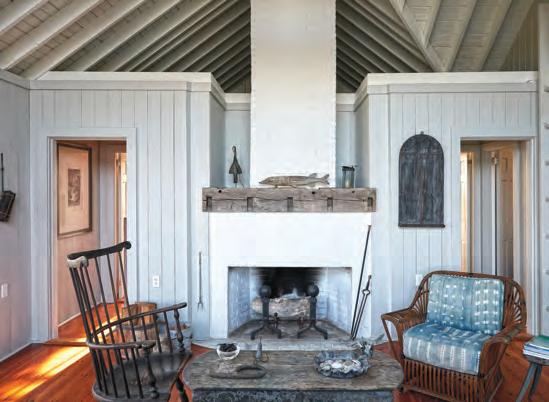
Once he had the house up and running, George began hosting dinners. They became more intentional and regular when he got involved in the Island’s Black Lives Matter movement. As he tells it, “So many important conversations started at
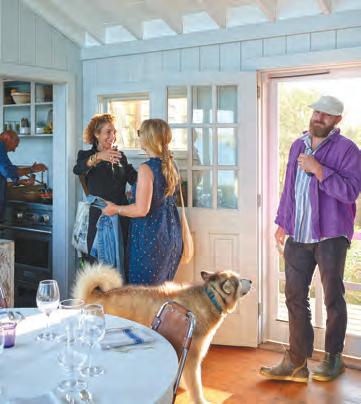



Beetlebung Corner kneeling in the morning. I wanted to keep them going. You can’t have the kind of conversations I craved at a restaurant. At home, the evening might start with drinks at 6:30 and people leave at 11, whereas at a restaurant, you don’t have the same space and time for interaction.” George also limits these dinners to eight people. “I like eight because you can have several voices but one conversation.”
Seated at this evening’s table were “Vineyard Folk” author Tamara Weiss, artist Colin Ruel and his wife jeweler Nettie Kent from the Ruel Gallery, Dan and Angela Henry, and Salte and Slate owners

22 edible VINEYARD
George at the West Tisbury Farmers Market.
Setting the table for a late season dinner party on the pond.
Fireplace in the cozy living room.
George’s home on Chilmark Pond was originally a fishing camp.
Late-afternoon table scape.
George In his Chilmark kitchen.
Tamara greets Nettie and Colin at the door.
Liz Hynes and Tom Juster — and George.
The dinner was on a clear Friday evening. George had started cooking on Tuesday, making the dough for the plum tart and roasting the tomatoes for the tomato tarte tatin and shallots for his simple salad dressing. “I like to get things done ahead of time so I can actually talk to my guests,” he says. On Wednesday, he went to the Farmers Market for squash, greens from Beetlebung Farm, peppers from Milkweed Farm, and to Mermaid Farm for the feta. George buys his fish from Stanley Larsen at the Menemsha Fish Market. “I like that he is open year-round. He gave me an

incredible cut of harpooned swordfish.”
“The swordfish was incredible. So was the tomato tart. But I think my favorite part of the evening was when we were sitting out on George’s deck and Angela and I looked up at the sky and she was like, ‘What is that?’ None of us knew. It looked like a shooting spaceship. It turned out to be one of Elon Musk’s Starlinks that has been in the news. We all sat there for a moment, stunned by the sight and reality of it,” Colin remembers.
“I looked up and I was like ‘Whoa. Um guys what is this?’ We were all silent for a moment. And then we Googled,” Angela laughs.
Angela and her husband Dan first met
George at the 2020 BLM gatherings in Chilmark. “Dan and I say we want to get to know the B side of people. George does too. And that was what this night was about. Sitting around a round table, being able to see everyone’s face and hear what they are thinking.”
An evening at George’s begins with drinks and hors d'oeuvres on the deck, which always includes little necks cooked on the grill. “People always ask, what did you do to the little necks?” George says. “I literally put them on the grill, they open and I serve them. Delicious.”

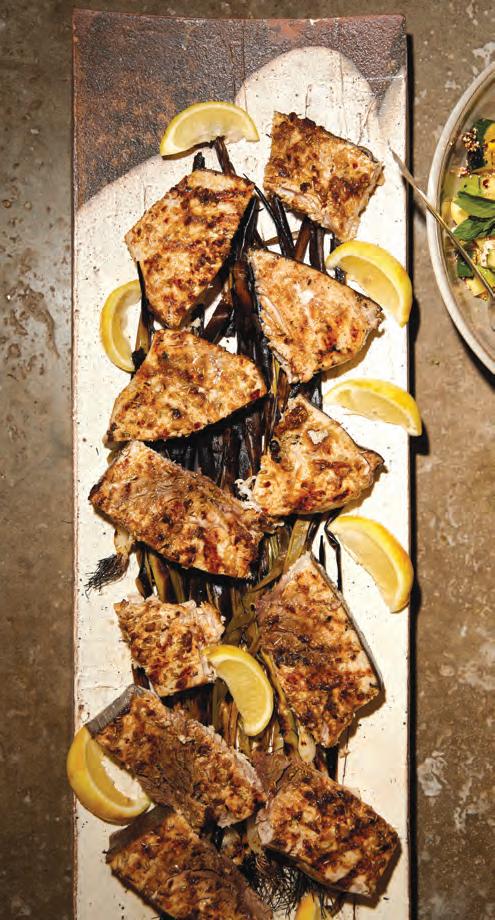
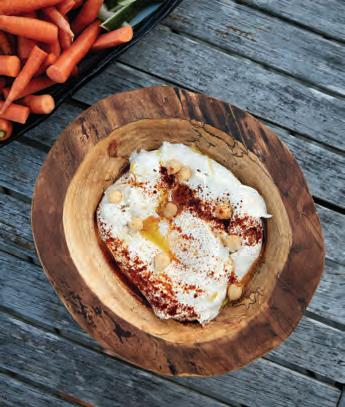
Continued on page 33

Eating with Vineyard folk FEATURE
George’s house, food, everything is like living in a painting. A living art.
A gallery for life. I can’t explain it, but it is really good .
– ANGELA HENRY
Lemon Hummus with Island veggies.
Carmalized Tomato Tarte Tatin.
Grilled harpooned swordfish from Menemsha Fish Market.
North Tabor Farm Baby Squash Salad with Mint and Feta.
harvest
23
Shortbread Plum Tart.
season 2023
There was no Tik Tok back in those days. We had clams and blueberries to keep us busy. We were summer people, our family rented a cottage that belonged to Eddie Cottle down by the entrance to Lambert’s Cove Beach. And when you walked down the path to the beach with the smell of honeysuckle filling your nostrils and the heat of the sun on the sand rising up between your toes, it was about as close to heaven as it would get for a 10-year-old kid from the suburbs. Unless, of course, instead of going down to the beach you went up into the woods behind the house to the forest that decades later would be called Longview and feasted on the acres of wild low-bush blueberries that thrived up there. And that was a different kind of heaven entirely.

Every morning before breakfast we’d pick blueberries for blueberry pancakes and make sure to save some for one of Mom’s pies.
Mom had a gift for pies. Michelangelo had his ceilings, Annette had her pies, ask anyone, they were that good. It wasn’t that they were just delicious, there was something about the very architecture of the pies that made you walk away saying, “Now, that was an Annette pie.”
And it was a secret she would never part with, refusing to tell even her own family. And were it not for me listening to an America's Test Kitchen podcast one day on the beauty of baking with lard her secret would have gone with her to the grave. It also explained why there was always a little tin of lard in Annette’s fridge. Health and fitness be damned, Annette was larding her pies.
We continued going to Lambert’s Cove for several more years, but in the late 50s our good friends from home, Norm and Jane Fuller and their two daughters Melinda (Loberg) and Melissa (Cross), invited us to their little cottage at the end of Herring Creek Road in Vineyard Haven, by the breakwaters on the beach where Lake Tashmoo connects with Vineyard Sound.

The Tashmoo house introduced us to a whole new side of the Vineyard. Out the back door was Lake Tashmoo and the wonderful world of bivalves. To us kids, everything about clams and quahogs was not only delicious but inherently funny, starting with the name itself.
I’ve seen it spelled quahog, quahaug, cohog, apparently you can spell it any way you want, which is in and of itself hilarious. To get quahogs you can either rake for them, which allows you to maintain a
24 edible VINEYARD ESSAY
Reminiscing about dining on the Vineyard in the 1950s.
The camp at Tashmoo, where Geoff found the wonderful world of bivalves.
Places like the Crick House are a vanishing breed.
certain amount of dignity. Or, you can muck about in the mud and dig for them with your feet — and there is no way to do that while maintaining even a shred of dignity.
Think John Cleese from Monty Python and the Ministry of Silly Walks. I actually wrote my admissions essay to Brown University on quahogging. Which, among other reasons, explains why I never got accepted. Apparently it was a little downmarket for The Ivy League.
Another aspect of quahogging, at least at the Fuller’s house, was the great pride we took not only in our digging technique (we were foot diggers) but the recipes passed down from Melinda and Melissa’s grandmother; a recipe not only for chowder but for what we called “Quahog Stuffies.”
The Fullers nextdoor neighbor, renown chef and bon vivant Joe Hyde, felt inspired
to paint the family recipe for quahog stuffies on the kitchen wall of the house, something that must have irked my mother who preferred to keep her recipes to herself.

I mentioned that out the back door of the cottage was Lake Tashmoo, but out the front door was a sweeping view of Vineyard Sound and the Middle Ground, which offered some of the finest fishing on the coast. In the Middle Ground’s heyday we kids would go out in our little runabout with drop lines and fill up a 55-gallon drum with flounder. We’d pull up on shore, clean the fish, keeping what we'd need and selling whatever was left to John’s Fish Market. Not a bad pay day for a bunch of rag-tag kids who didn’t even have driver’s licenses.


Admittedly, this is beginning to sound like a paean to preteen hunter gatherers, but let it be known that not everything came from the earth and the sea. Two other major food groups we especially enjoyed were jelly donuts from Bart Humphries’ shop in West Tisbury, burgers from the Ag Fair, and soft serve ice cream from what I remember was the Dairy Maid on State Road where Cronig’s is today. Sometime in the 50s, they installed high-tension wires up in the hills above Tashmoo, clearing out large swathes of land which made it possible to walk up to State Road.
Tina Miller, co-editor of Edible Vineyard magazine, remembers her father calling it onomatopoetically “The Drippy Drool,” which, come to think of it, is a much better name than the Dairy Maid.
Melinda Loberg was kind enough to share her grandmother’s recipe for Quahog Stuffies.

Ground quahogs — a bucket
Chopped onion, garlic, peppers, or celery as available
½ - 1 cup breadcrumbs
Add herbs — oregano, thyme — use your imagination
Moisten with some clam broth
Top with Parmesan
Combine and put in shells
Cover with slice of cheese — Havarti with dill and a slice of bacon
Bake at 350 until bacon is cooked.
Run under the broiler for a few minutes.
Melinda added this comment that took the recipe to new heights: “Intriguing on so many levels.”
harvest season 2023 25 A kid and his bucket ESSAY
John's Fish Market, left, and Mike Fontes' paint shop, right, when they were located at Five Corners.
The famous stuffie recipe on the wall at the camp.

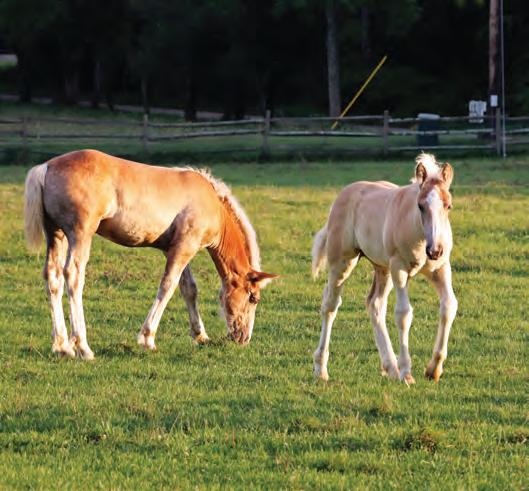


26 edible VINEYARD PHOTO ESSAY
Nursing foal at Nip ‘N Tuck Farm.
Foals, Crown and Royal, at the farm.
Beasts of burden
Draft horses are true team players, worker bees of the hooved variety.
 IMAGES Sadie Dix
IMAGES Sadie Dix
Draft horses are one of the gentle giants of the animal kingdom. Tall, muscular, statuesque, strong, mellow, patient, and sweet could all be used to describe the draft horse. With around 20 different breeds recognized worldwide, these beasts of burden are built for pulling and hauling. Draft horses are team workers often seen in pairs. At Nip ‘N Tuck Farm
in West Tisbury, two of their Belgian mares had foals this past summer, which has given us a reason to pull over and admire these beautiful babies grazing with their attentive mothers nearby. There are, no doubt, big plans ahead for the long-legged, big-kneed youngsters. For now, the foursome — mares and foals — graze and frolic in one of up-Island’s most picturesque rural views.

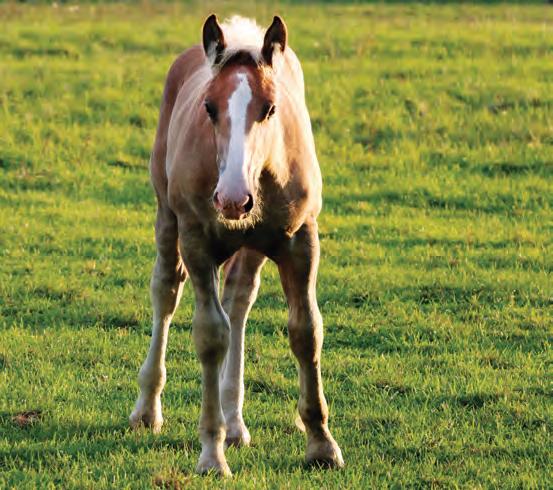
harvest season 2023 27 Beasts of burden PHOTO ESSAY
Belgian draft foal at Nip ‘N Tuck Farm.
Belgian draft mare and foals.
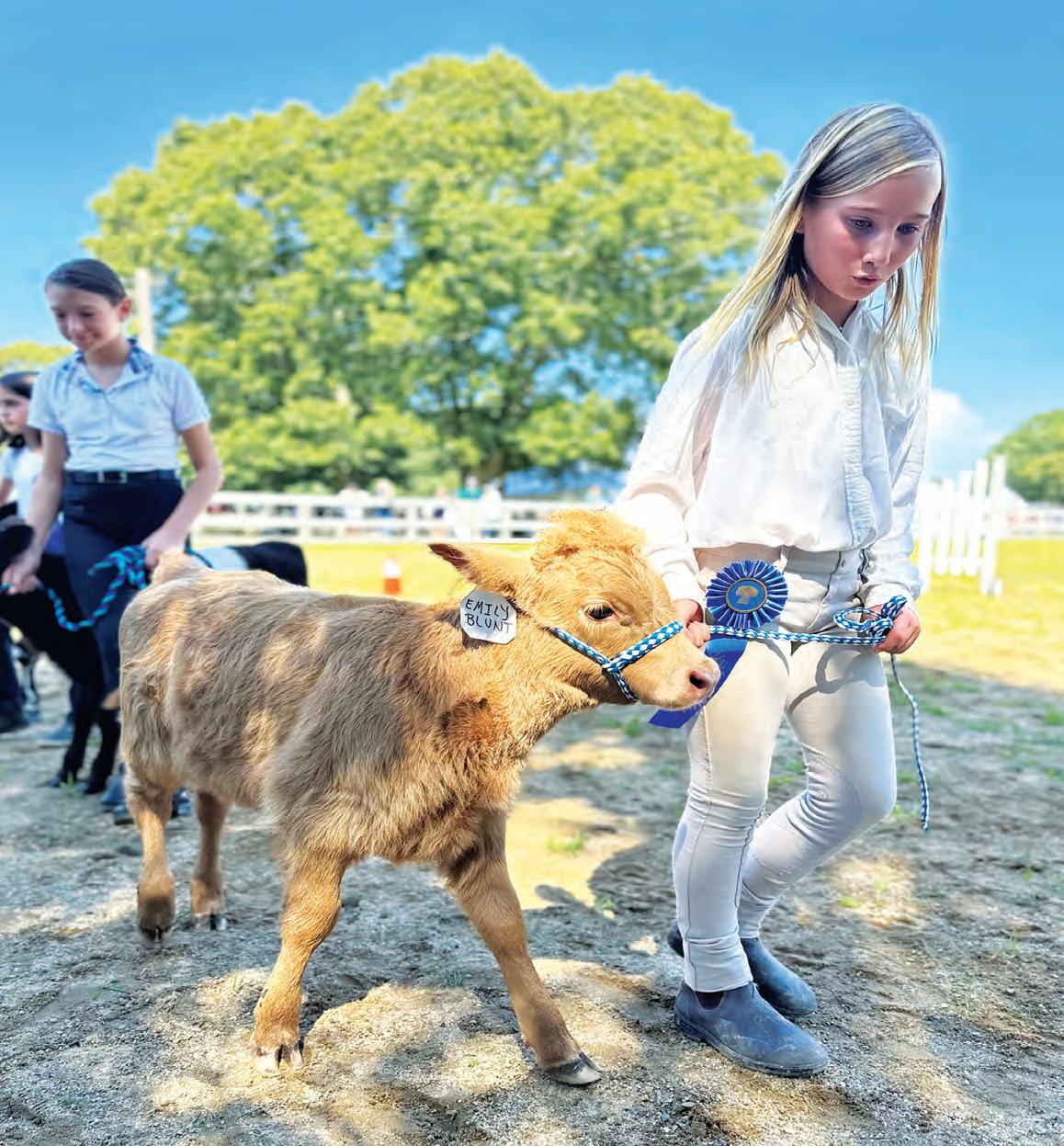

28 edible VINEYARD
The Island now offers a revitalized program, with six very active 4-H clubs.
WORDS Julie Scott IMAGES Brooke Bartletta
ON THE FARM
Calves have been trained on halters by 4-H kids and shown in the M.V. Agricultural Fair.
I’ve known I wanted to be a livestock farmer since I was 12 years old, despite growing up in a community with almost zero agriculture. Acknowledging that it is pretty unlikely that someone would know their calling at such a young age, we as parents try to make it so our kids can experience as many different things as possible to help them find what they love. Even if what they love doesn’t turn into a career, a childhood filled with something to look forward to, something that makes them feel important, something that sets them up with skills that will prepare them for adulthood, is a special thing to find. 4-H is all those things. Its Hs stand for head, hands, heart, and health. It combines practical hands-on learning and commitment to community.
The over 100-year-old organization was formed in the late 1800s, when adults in the farming community were not very willing to accept new agricultural methods and systems. It took a smart individual to realize that young people tend to be open to new, creative ideas and are more willing to experiment. It probably also has to do with the fact that the young folks didn’t have a farm mortgage or a family to gamble on. Small youth “study” groups were formed with specific focuses such as “Corn Growing Club,” “Tomato Club,” and themes ranging from dairy calf raising to canning and preserving vegetables. Fast forward to 2023 and groups of kids all over the country are getting together to learn and experiment with the very same subjects as the youth of a hundred years ago.
Here on the Vineyard, 4-H, after a decades-long hiatus, has been reborn under the Martha’s Vineyard Agricultural Society’s (MVAS) programming umbrella.

In 2018, a group of us from MVAS traveled to the Barnstable County Agricultural Society offices to meet with 4-H directors from Barnstable and Plymouth counties. Armed with lots of knowledge and a revitalized sense of excitement, we returned to the Island and started recruiting new volunteer 4-H leaders. By 2022, six 4-H groups were formed with participants ranging in ages from 5 to 12 years old. The Crafts from Yesteryear Club meets at the M.V. Museum. The Winging It Club covers all things birds with the Sheriff’s Meadow Foundation, the Just a Pinch Baking Club is led by Elizabeth Bonifacio, Paint What You See Club is led by Allen and Lynne Whiting, the Farm Institute Cloverbuds — the youngest group — covers everything from food to art to farming and is led by Melissa Schellhammer, then there is my group, the Slough Farm Super Silos.
Holding the prestigious title of longest running 4-H group on-Island, the Super Silos started out as a Cloverbud group back in fall of 2018. It was open to kids ages 5 to 7 and didn’t have a specific theme. Just like the current Cloverbud group, we focused on gardening, livestock, art, cooking, and community engagement, staffing the Ag Society’s 4-H fundraiser, the Farm Animal Meet and Greet, each spring. Of the 10 kids that started out with our group way back when as 5 and 6-year-olds, we still have four who have continued and are committed to
gaining practical farming experience.
As kids grow up, they get into new things, start playing sports, make different friends, and can be less interested in getting their hands dirty. But in the words of Juniper Begin, age 10 and longtime 4-Her, “It’s fun because as you get older, you can do more things and have more responsibilities. I started out hatching chicks and now I’m handling cows and working at the fair.”
It has truly been amazing watching the kids gain confidence and learn responsibility from caring for an animal and being part of a group. This year, a select few spent extra time learning about halter-training both lambs and calves, landing them the incredible honor of showing them at the fair.
A 4-H group is encouraged to have a specific focus of study, but within that theme, allow kids to branch out and focus on their strongest interests. It is so incredible to have such a variety of offerings for our Island kids. As both a 4-H parent and leader, I share the sentiments of 4-H parent Erica Maloney who said about her two daughters’ experiences in 4-H: “It is truly an enriching experience for our community, offering valuable skills at young ages and opportunities for personal growth. 4-H has been a positive influence on our family, fostering a sense of belonging and the importance of responsibility. It doesn’t matter the weather, as long as they are with their group, they are happy!”
We can’t have great groups without great leaders! If you have some time to devote to an amazing group of kids, contact Lucy at MVASprograms@mvagsoc.org.
harvest season 2023 29 Learning and growing with 4-H ON THE FARM
Showmanship class at the 2023 M.V. Agricultural Fair.
FEATURE Coming Home
Continued from page 17
in some capacity, but I ultimately don’t want to live with my parents my whole life, and especially not where I work. My partner works here as well. So it’s just like, everything is here.
Where do you see yourself in 10 years?
I don’t really think too far ahead. I would love to be farming. I definitely want to have gone to a bunch of different places in the winter and traveled. Probably have my own spot. Love to see just some projects finished and cleaning up some stuff.
LIAM COSGROVE
Liam is a 26-year-old Islander whose love for the ocean keeps him here. In 2020, Liam and a business partner started Top Shell Oyster Farm after acquiring an aquaculture license from Edgartown to farm oysters out at Middle Flats, just north of Eel Pond. Liam says support from legendary oyster farmer Jack Blake and the Martino Brothers of Cottage City Oysters taught him everything he knows. Liam says his oysters are medium-sized, really sweet and creamy. He was off to a great start, selling his oysters through Cottage City Oysters.

When did you know you wanted to stay here?
Growing up on the Island, I always knew I needed to work on the water. After a brief stint at college and traveling the U.S., I realized that there was nowhere like the Island, and this was my home.
Why oyster farming?
After taking an oyster farm tour with Cottage City Oysters a few years back, Dan and Greg Martino said on the tour anyone interested in learning more about oyster farming to let them know. I stepped up and, to my surprise, was sold on it.
What do you love about your life here and your work?
The community here is absolutely crazy good. When I decided to start my business with a partner, we ran a Kickstarter campaign. I was overwhelmed by the support. You just cannot beat this community. To top that, I get to be on the water, taking my boat out to the farm. It’s gray and calm, and you cannot see where the sky ends and the ocean starts. I could live in that feeling forever.
What challenges do you see for the Island?
The housing crisis is really difficult. I am lucky, I actually have a year-round apartment rental with very good people. Many oyster farmers around the world make a little bit of money and buy waterfront properties so they can build facilities and scale their businesses. They could sell directly, but that can never happen. I will always have to use a middleman to sell my oysters.
Where do you see yourself in 10 years, your industry?
I would like to scale the business to a size I can supply a large chunk of restaurants, making this my only job. I do not need to do anything but farm oysters. Oh, and own a home, of course.
JULIA FELIX
Julia is 23 years old and the greenhouse manager at Morning Glory Farm. Julia graduated from the University of Maine with a degree
in sustainable agriculture and a minor in resource agribusiness economics/leadership. A stroke of luck and an online help-wanted ad brought her home and to a career in farming she loves.
When did you know you wanted to stay here?
Honestly, throughout most of college, I would have said I wanted to be anywhere but the Vineyard. As graduation got closer, I was more and more unsure of where I wanted to be and how I wanted to start my career. About a month before graduation I was sitting in my 8 am propagation class and thought about how I grew up in a place with such a strong agricultural community. I googled “agricultural jobs Martha’s Vineyard” and Morning Glory Farm popped up, and I applied. I told myself if I got a job at the farm, I would return home, and that’s what happened. I’m so grateful for the opportunity Simon Athearn and Ryan Hassell gave me, and now I couldn’t be happier that I decided to come back to the Island.
When did you figure out farming was what you wanted to do?
Well, I grew up going to my grandparents’ dairy/livestock farm in Brazil, and my dad has owned a landscaping company basically my entire life. I was around agriculture and was taught about plant care and propagation from a young age. I was always drawn to plants and farming, which could have been a product of my environment, but I think I did always have
30 edible VINEYARD
Liam Cosgrove and a business partner started Top Shell Oyster Farm.
an innate interest in the industry. However, I took a gap year before I went to college, and spent time working on an aquaponics farm in Hawaii. I loved the work and fulfillment that came with feeding people. I guess that experience is what gave me the definitive idea that I wanted to pursue a degree in plant or agricultural sciences.

What do you love about your life here and your work?
I guess I enjoy being home because of my job and being able to see my family. Over the past few years I scarcely saw my parents and sister, because I was always busy with work and school. As for my job, I love getting my hands dirty, working with plants, and learning new things all the time. Also, MoGlo has a phenomenal workplace environment and I genuinely like being there.
What challenges do you see for the Island?
I think the challenges I see for the Island are the ones we are facing now — housing and the cost of living. In my opinion, the housing issue is going to continue to worsen and the cost of living will just keep increasing. I think the community is taking strides to improve these issues, but they are difficult issues, and I think the Island will always face them. I’m noticing less and less kids who leave and get degrees return home. I think these individuals could be really beneficial to the community, so providing them opportunities and incentives to come home is important.
Where do you see yourself in 10 years, your industry?
Ten years is far away, and I don’t really have a concrete path I want to follow. Although, I do see myself pursuing a career in horticulture and going back to school. I really enjoy learning and continuously expanding my knowledge; I do want to reach for a higher-level degree eventually. As of right now, I’m happy where I am, and plan to stay for a while.
THEO GALLAGHER
Theo is 23 years old and is in his fifth year farming at Beetlebung Farm in Chilmark, where he is the soil fertility and integrated pest management lead. After studying sustainable agriculture at University of Maine for a year, Theo decided he was ready to get to work focusing on soil science and soil heath. Beetlebung Farm was the perfect fit because the farm’s mission is to restore the soil using regenerative practices while growing a thriving market farm.

When did you know you wanted to stay here?
I have thought about Maine, but I feel like this Island has so many, well-resourced, cool farming opportunities. During high school, I worked as a landscaper and then for Grey Barn. Then, in 2019, when Beetlebung changed hands, I was their first hire. I have been here ever since.
harvest season 2023 31
Julia Felix, greenhouse manager at Morning Glory Farm.
Theo Gallagher is is the soil fertility and integrated pest management lead at Beetlebung Farm.
When did you figure out regenerative farming was what you wanted to do? It wasn’t a decision. When you are farming, things slowly come together. With regenerative farming, you first learn that there is more nutrient density. Then you see how it restores the land. And then you taste the food and it just tastes better.
What do you love about your life here on MV and your work?
Everyone is trying something, working on ideas. And it is not competitive. There’s a great sense of community. We all get along. I ran into Whippoorwill’s Andrew Woodruff at the gas station the other day and we spent about 20 minutes talking about soil. I love that. I have a lot of gratitude for this place. We can all get caught up in how things should be, but it is really beautiful here. I can be anywhere — the beach, the woods, in a field or even eating the food — and I feel the beauty.
What challenges do you see for the Island?
Housing. If we don’t solve this, we won’t have a community. I live with my family. If I didn’t, I might be able to stay, but it would be tough.
Where do you see yourself in 10 years, your industry? Your hopes. I’d be running my own farm here. Growing a combination of veggies and flowers.
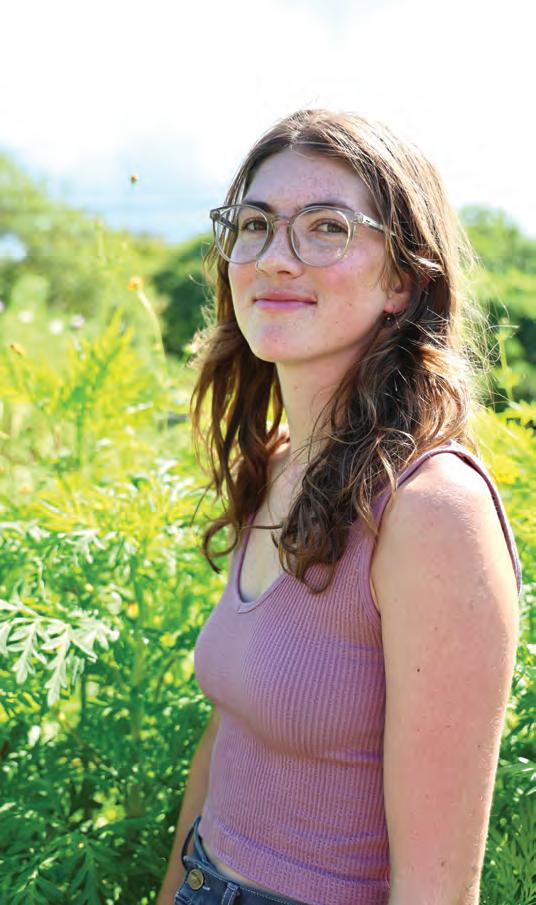
GRACE KENNEY
Grace is about to turn 24 and graduated from Bennington College. Grace spends her spring and summers at Tea Lane Farm in Chilmark where she co-manages the farm, growing flowers and working floral design for weddings with Krishana Collins, the farm’s owner. Starting in November, and through the winter, Grace will scallop with her partner Matteus Scheffer in Edgartown.
When did you know you wanted to stay here?
I certainly already knew it. I really love the community here. And that was one thing that I struggled with when I went away to school was sort of being plopped somewhere else. Like you're not really part of a community but you are. It just wasn't what I was looking for. I don't even know the word but it just wasn't what I wanted. I really wanted to dig my roots in and be somewhere and start building on that community and being a part of that community. So I sort of knew that I wanted to come back here.
What do you love about your life here and your work?
I really enjoy being part of a community, and like being part of a place where there's such a heavy agricultural and farming community. I love having my foot in both doorways [farming and fishing]. It is really interesting. And I wouldn't want to do it any other way, because I couldn't choose which one I liked more. It's nice. And I just think that they're both so important to feed and fuel the Island itself. I think without the farming and agriculture and the fishing industry, Martha's Vineyard wouldn't really be Martha's Vineyard.
What challenges do you see for the Island?
It's really hard when this community is so special and so inviting, but at the same time is just closing doors on young people because there's just so many things that this Island is struggling with. It's not easy for a young person to struggle with because there's not a lot of doors that are open for a 20-something-year-old to find a
house. You're struggling with housing and it’s just ridiculous at this age, and then you hear all these stories of people being like, ‘well, I did it so you can do it.’ But now it's changed completely.
Where do you see yourself in 10 years, your industry? Your hopes. I wish I knew the answer to it. But I do hope that I'm here and I hope that I have the ability to either buy land or find land or have a little bit more stable option in those 10 years with housing. I hope to still be farming or fishing or doing something in that because I really do love it and it's important for my soul on this Island.
32 edible VINEYARD FEATURE Coming Home
I really wanted to dig my roots in and be somewhere and start building on that community and being a part of that community. So I sort of knew that I wanted to come back here.
–Grace Kenney
Grace Kenney, co-farm manager at Tea Lane Farm.
Continued from page 33
As the sun set over the water and swallows bounced in the sky, finishing their evening meals, George grilled.

“I have to move the grill around the deck, depending upon where the wind is coming from. If there is too much wind on it, it is not hot enough. Before putting it on the fire, I spread a combo of coriander, cumin, garlic, lemon, and olive oil on the swordfish before grilling it — more of a paste than a marinade. Then spread it on the reverse side once on the grill. I just plate it with mint and lemon wedges.” Simple and delicious.
Guests headed inside to dine at the home’s oval table. George’s salad included roasted shallots, avocado, and grilled shishitos. His go-to salad "dressing" is “EVOO, white balsamic, flaky sea salt, and ground pepper. “I pour each over the salad and mix it in the bowl. I'm light on the ‘dressing’ and people
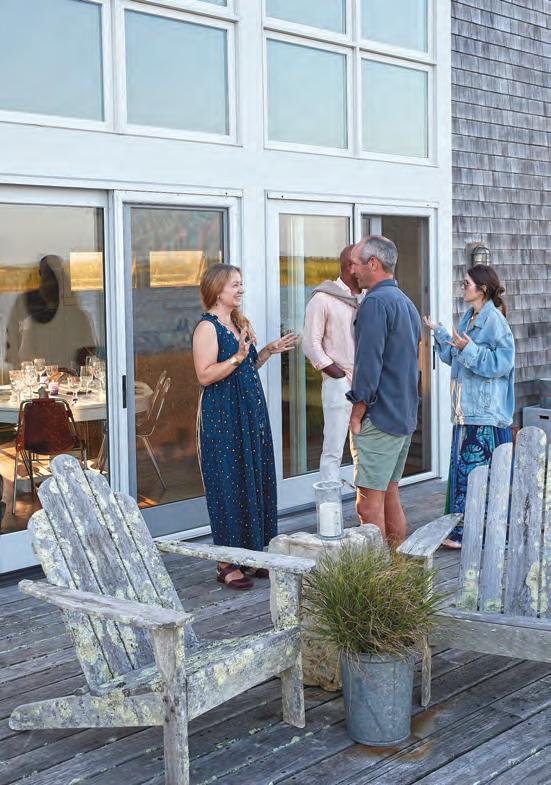


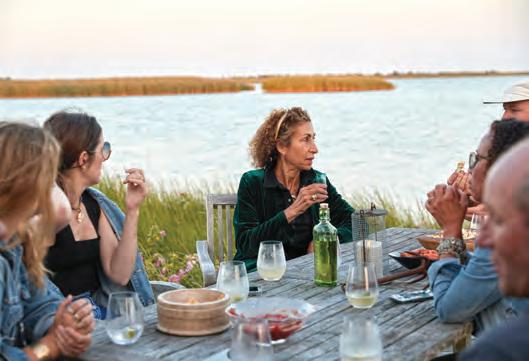
seem to love it — the taste of the greens comes through. It's the roasted shallots that make it! I roast a big batch every week.” The recipe is simple: 350 degrees on a sheet pan with EVOO for 30 minutes, stir, two more 10-minute blasts and keep them in the fridge.
“George’s house, food, everything is
harvest season 2023 33
Growing up, we all helped our mom cook.
‘Larousse Gastronomique’ was her bible. – GEORGE AHL
Eating with Vineyard folk FEATURE
Guests gather.
Dan Henry, Nettie Kent, and Liz Hynes.
Tamara Weiss with Chilmark Pond backdrop.
The guests enjoy drinks and appetizers on the deck.
View of Chilmark Pond.
FEATURE Eating with Vineyard folk
like living in a painting. A living art. A gallery for life. I can’t explain it, but it is really good,” Angela says, laughing.
It’s true. In addition to supporting local farms, George’s meals also support local artists. George served the Grey Barn sausage with a handmade knife by Colin. The Micah Thanhauser platter that hangs on the wall in George’s bedroom was also used to serve the spring onions and fish. And potter Candy Sweder’s plate hosted the evening’s dessert.
Tamara, who has been a dear friend of George’s for years and grew up playing cards in the house on rainy summer days
when the Asher family owned it, says, “He is a master curator of all things LIFE. His environment outside and inside is so important to him. He is most happy when surrounded by water or woods, ocean or mountains, under big skies. He brings the outdoors in, whether it be a rock, an animal skeleton, an old fishing weight, etc. He has added a few windows to his home since I have known him, which truly enhances the experience of dining at the pond house — or rather on the pond. One could fish from his deck! His passion is fueled by his desire to share, and he does that beautifully with his numerous
dinners. He curates the meal as well as his guests, always ensuring that his table of eight will engage in lively intellectual and stimulating discussions. He is a master chef, a wizard of sorts, a lover of all things Chilmark and Martha’s Vineyard.”



As Tamara tells it, George is the embodiment of her book “Vineyard Folk,” which celebrates the intersection where art, food, nature, water, and connection and community all meet. Here on Martha’s Vineyard, that intersection is usually down a dirt road, around someone’s dinner table with friends — new and old — feasting on a home-cooked meal.
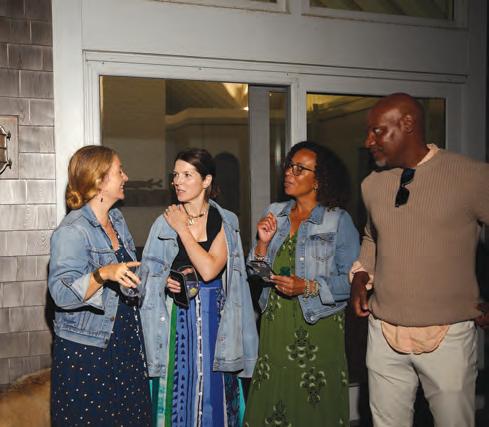
So many important conversations started at Beetlebung Corner kneeling in the morning. I wanted to keep them going
.
34 edible VINEYARD
– GEORGE AHL
George getting ready to serve up his Shortbread Plum Tart.
Nettie Kent, Liz Hynes, and Angela and Dan Henry.
Liz Hynes in the kitchen.
A toast to the feast and endof-the-season get-together.
The Fischers of Flat Point
The Land Bank’s Short Cove trail starts with a short stretch of woods, then passes a wide, stubbly pasture frequented by wild geese, turkeys, and deer. Past another stretch of woods, the trail crosses a pasture down to the shore of Tisbury Great Pond. The cows or sheep along the way offer a glimpse of the farm. In 1939, Arnold Fischer was a recent graduate of UMass Stockbridge when he bought Flat Point. The land was covered with scrubby woods and it took him many years to clear the pastures, but in the process he created a place that has endured, and which his family still farms today.
The Fischer family’s history on the Vineyard stretches back hundreds of years. In the early 1910s, Albert O. Fischer, senior, “drifted here from somewhere,” more or less from New Jersey via Nantucket, according to his granddaughter Eleanor Neubert. He was an adventurer and a jack-of-all-trades, and was staying at the Mansion House in Vineyard Haven when he met a local girl, Ethel Morton Luce. The Luces are an old and prolific Island family; Henry Luce, Ethel’s several-times-great-grandfather, had settled near Scotchman's Bridge Lane in West Tisbury some time before 1671. According to “The History of Martha’s Vineyard,” by Charles Edward Banks, he also owned land at Great Neck, the same area where Flat Point Farm is today. He had 10 children, mostly boys, and so the Luce name spread around the Vineyard.
Ethel Luce and Albert Fischer had four children in rapid succession, Fred, Ozzie, Arnold, and Lois, all between 1913 and 1917. All three boys went to study agriculture; Fred studied fruit and vegetables, Ozzie studied poultry, and Arnold majored in dairy. Lois went to nursing school. Ozzie became the caretaker at the Keith Farm in Chilmark, and bought Beetlebung Farm in the 1960s. Arnold started keeping cows in Vineyard Haven, in the area around Skiff Ave. In July of 1945 he was delivering milk and met Priscilla Pettingell, a teacher who was working in a hotel here for the summer, and they married at the beginning of November.
The newlyweds drove the cows up to Flat Point and moved in, with Arnold’s parents in tow. His father, Albert O., helped out with the farming for several years. Eleanor was the first of four children, three
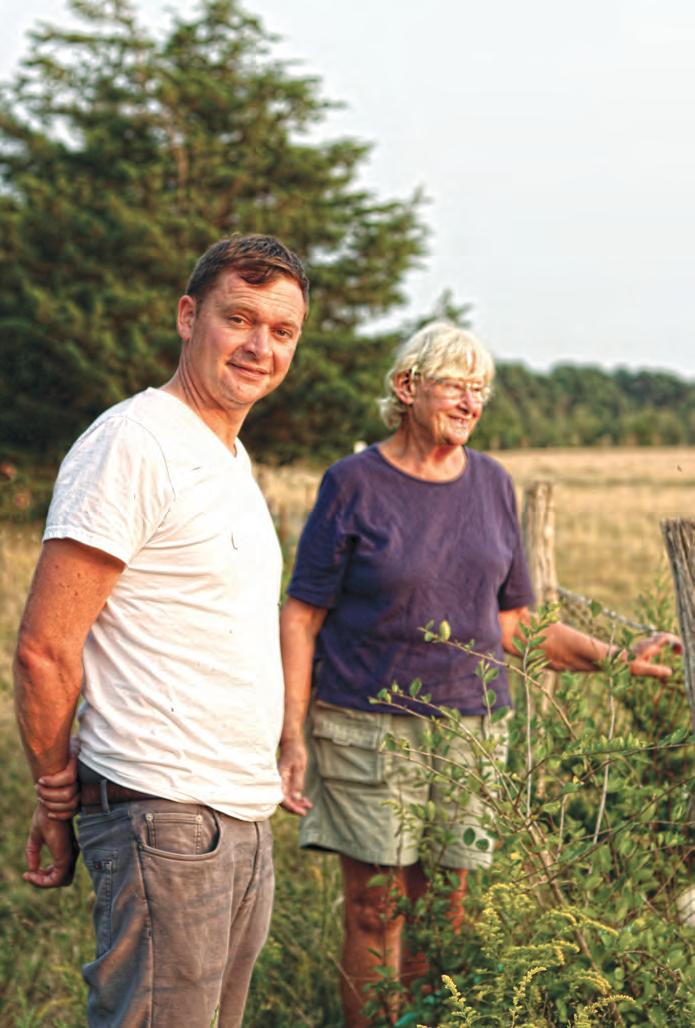
harvest season 2023 35 The Fischers of Flat Point FEATURE
WORDS Amelia Smith IMAGES Sadie Dix
Generational farming at Flat Point Farm means everyone works together to carry on traditions.
Mason Fischer and Eleanor Nuebert on the farm.
girls one after the other, then a boy, Arnie, four years later. “At the time, there were 28 relatively good-sized dairy farms,” Eleanor says of her childhood. She and her sisters would drive around with their father to check on the cows they pastured in Gay Head, tend to the sheep they kept at Sarita and Joe Walker’s, and all over the Island for one errand and another. They spent time in the barn even when they were too little to help, just to get them out of the house, and later they had chores to do.
These days, Arnie is the principal farmer. He does most of the tractor work on the farm and takes care of the pigs, cows, sheep, and land — there’s still brush-cutting to do — and there are always repairs. He’s always trying to improve areas of the farm in one way or another. Arnie and his wife Christa were off-Island on vacation when I visited to write this story, and so there is a hole in the middle of it, but his absence reveals the community around his work. Eleanor takes care of the hens and sells their eggs. Christa works with the sheep’s wool, and dyes it with plants from her garden. Their daughter Emily raises goats and makes soap with their milk. Their son Mason lives here in the warmer months of the year and helps with the farm work when he can. Lydia, a second cousin, tends a quarter-acre vegetable garden and sells its produce.
Bringing the children along but not forcing them too much to do chores has kept each generation inspired to take up farming in their turn. Emily lives in a new house on the farm with her husband Doug Brush and their children. Like their mother before them, the boys don’t have
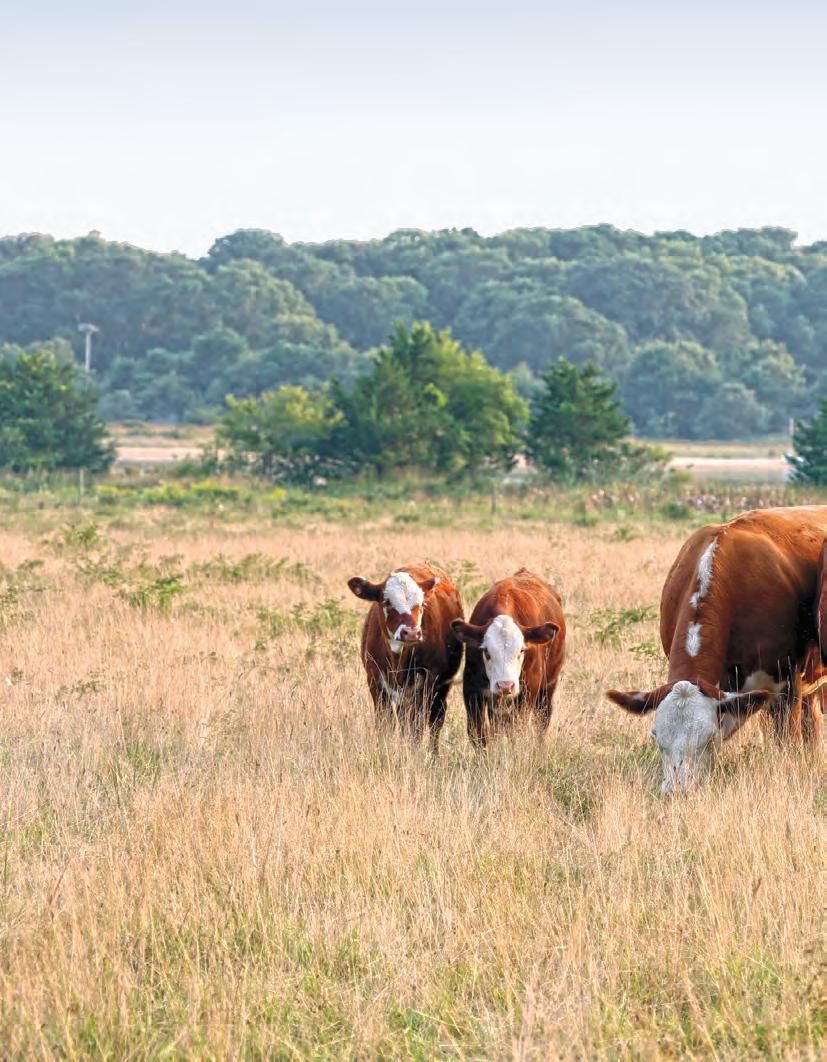


FEATURE The Fischers of Flat Point
Mason checks the lambs.
36 edible VINEYARD
Eleanor is heading to the coop for eggs.
set chores, but they’re involved. “Milo and Leon can both milk and throw hay,” Emily says. “The winter chores are easier, so they can help with that.” Of Arnie, she says, “My dad is not a forcer of help. He just lets us help how we want to, because then it makes you want to help, rather than feeling like an obligation.”


While Arnie is away, Eleanor and members of the younger generations fill in. In the summer, Mason plays a big role in that. Despite their four-decade age difference, Eleanor and Mason have a lot in common and an easy rapport. They divide the chores according to what suits them and their schedules. Because Mason works regular hours as a computer programmer, Eleanor does the morning chores, but he moves the heavy water buckets and feeds and waters the pigs at night. Both Eleanor and Mason’s first memories of life on the farm center around the barn, and both remember sweeping down the middle of the barn as an early chore. “I went out to the barn every night,” Mason says. He boxed up the eggs with neighbor Casey Decker, and the two of them drove around the farm in go-karts.
Haying brings in a multitude of friends and neighbors. Everyone at Flat Point helps, and they all seem to enjoy it. When Eleanor was young, Uncle Ozzie
harvest season 2023 37
My dad is not a forcer of help. He just lets us help how we want to, because then it makes you want to help, rather than feeling like an obligation.
The Fischers of Flat Point FEATURE
– Emily Fischer
Beef cattle graze on the open fields by the pond.
came down from Chilmark with his crew, and later families who had horses came to help in exchange for hay. One of Eleanor’s jobs on the farm is driving the tractor for haying. Her father used to drive the tractor and the girls would sit on his lap when they were little, and at age 8, Eleanor was driving the tractor herself. Mason learned to drive the tractor at about the same age, 41 years after Eleanor did. On hay day now, Mason drives the tractor to the field and Eleanor drives it around once they get there.


Uncle Ozzie’s granddaughter, Lydia Fischer, moved to Flat Point a few years ago. Her father was the caretaker for the Onassis property and had a huge garden, and at age 12, Lydia had her own herb garden. After graduating from Berklee College of Music, she moved to New York City for a while, but returned to the Island after a stint in reality TV casting. She gardened for a season at her grandparent’s property at Beetlebung, but also worked at Morning Glory Farm, where she immersed herself in learning all about tomatoes. A few years ago, her Flat Point cousins invited her to garden there, where Arnie’s quarter-acre vegetable garden was lying fallow, and a bit of housing had opened up there, too. Five years later, Lydia’s “Garden Farm” project grew more than 400 tomato plants this year, in 20 varieties, plus edamame, black beans, corn, and more.
For all the work it requires, hay, sheep, and chickens have never paid all the bills.


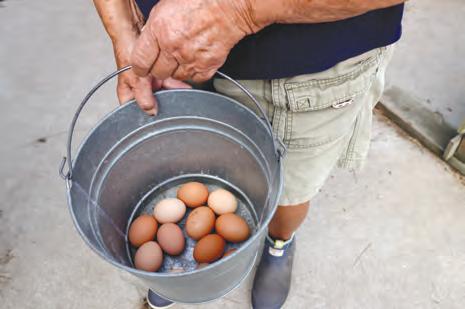
38 edible VINEYARD
FEATURE The Fischers of Flat Point
Lambs graze at the edge of Tisbury Great Pond.
Flat Point farmstand and barn.
Eleanor collecting eggs.
The patience I’ve learned working with children has really helped in dealing with some farmers market customers.
– Lydia Fischer
“We were all told that we were going to attend college,” Eleanor recalls. Her father Arnold “went to bang nails with Daniel and George Manter,” and Arnie had a landscaping business, Moonlight Gardening and Caretaking. Priscilla started teaching first grade as soon as Eleanor started first grade, and went on to be the first principal of the West Tisbury School in its current location. In her turn, Eleanor was a teaching assistant for the younger grades at the Chilmark School for over 30 years, and Christa was a teaching assistant at West Tisbury. Currently, Doug Brush teaches fifth grade math and science, and Lydia works in a fourth grade classroom as an educational support professional, both at the West Tisbury School. “The patience I’ve learned working with children has really helped in dealing with some farmers market customers,” Lydia says. Their teaching salaries might not be large, but they’re steady in a way that the farm’s income never has been.
Teaching and education are the invisible glue that holds the farm together. Doug and Eleanor brought their classes out to see the farm, often when there were new lambs. The farm inspires rather than insists, thanks to the many teachers there. It can also inspire the rest of us as we benefit from the 2013 conservation restriction and public paths, or visit the barn to buy eggs, beef, pork, lamb, and hay. It’s an intergenerational project that reaches out to the wider Island community, even those who aren’t blood relatives.

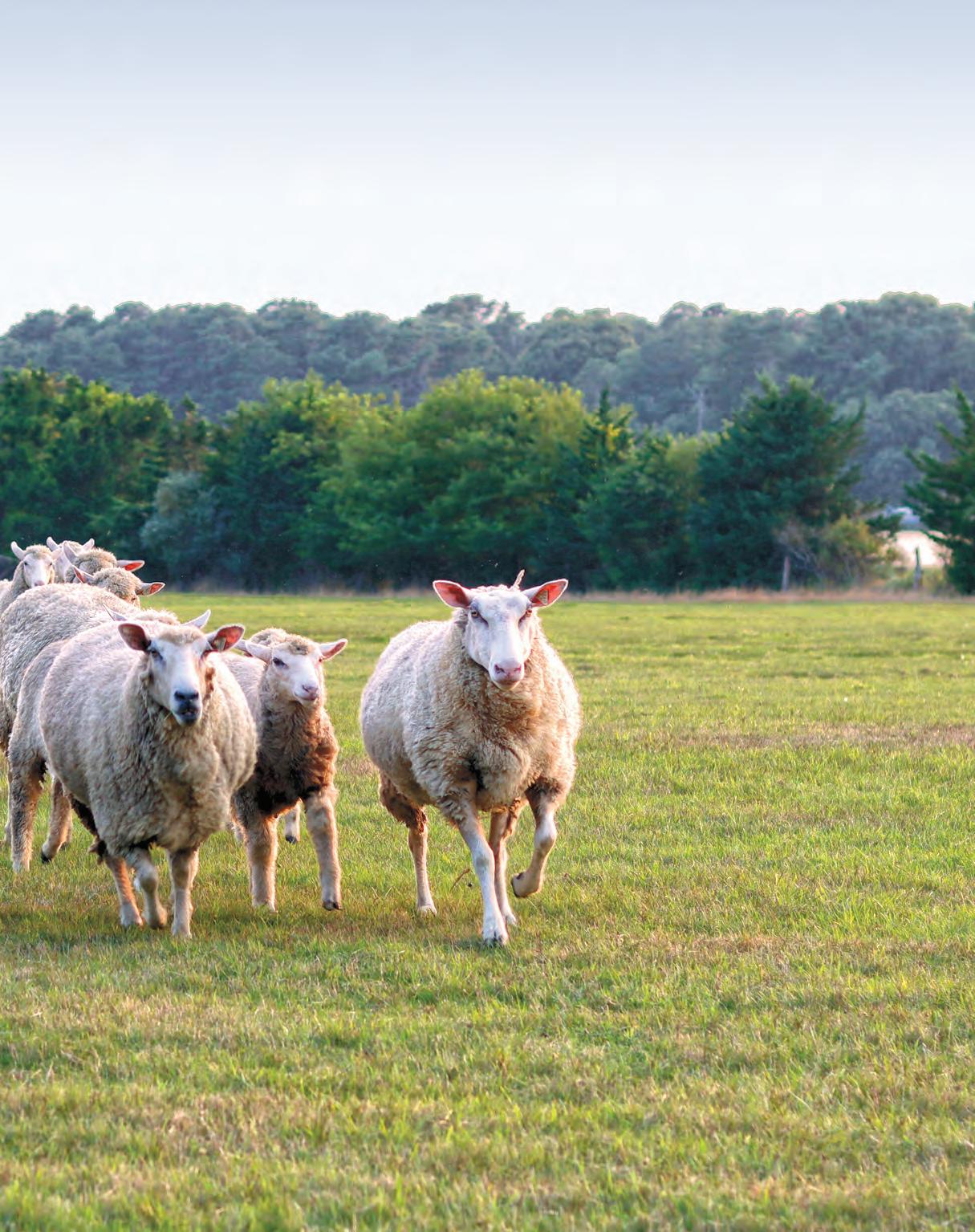
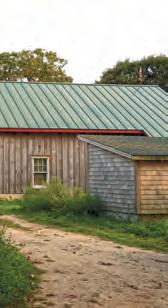

The Fischers of Flat Point FEATURE
harvest season 2023 39
Eleanor and Mason with the lambs.
Classic codfish cakes
WORDS + IMAGES Tina Miller
This recipe is from my cookbook, “Vineyard Harvest,” (Random House 2005), and is certainly one of the most popular in the book. These simple, light cod cakes can be made into small appetizers. Here I make them larger

for a nice fall dinner and serve them with a hearty salad, lemon wedge, and maybe a homemade tartar sauce. The cakes can be made up ahead of time and reheated in the oven, perfect if you are making a smaller appetizer size for a party.
Codfish Cakes
2 lbs. fresh cod filets
1 cup Italian parsley leaves 1 onion, peeled and rough cut 3 ribs of celery, rough cut ¾ cup mayonnaise
2 tsp. Dijon mustard
2 Tbsp. fresh lemon juice
Salt and pepper to taste
Hot sauce, a few drops
1 cup bread crumbs (gluten-free works great as well)
High-heat oil such as sunflower, safflower, or canola
Preheat oven to 350 degrees.
Place cod filets on a baking pan with parchment paper. Bake for 20 minutes, let cool.
Using a food processor, chop parsley leaves. Add onion and celery, and mince combining together. Remove and let sit in a fine strainer to drain. Squeeze to remove excess liquid.
Remove cooled codfish from the baking pan without liquid.
Add to a mixing bowl, add parsley, celery, and onion mixture. Add the rest of the ingredients, folding in the bread crumbs last, combining well by hand.
Shape the mixture into about 4-inch by 1/2-inch round cakes. Set on a tray lined with parchment paper. Let chill in the fridge for at least 30 minutes.
Heat oil enough to cover the bottom on a heavy sauté pan such as carbon steel or cast iron on medium-high heat.
Sauté until golden and gently turn and repeat. Do not turn cakes more than once; they are delicate. Let them cook until a nice golden crust is uniform before gently turning.
Whether a meal or appetizer, this seafood staple is light and delicious.
IN
SEASON
School lunchscratchfrom
conversation with Betsy
who runs the Charter School food program with sustainability in mind.
Local eggs, basil, and tomatoes will go into lunch at the Charter School.

School lunch from scratch FEATURE
A
Carnie,
WORDS Mollie Doyle IMAGES Tina Miller
Five years ago, Martha’s Vineyard Public Charter School head chef Betsy Carnie imagined a new school kitchen for students. “I wanted to start from scratch. I had a few lines in the sand. For instance, we would only serve meat from here and offer local Massachusetts milk. No seed oil, because no industrial fats for growing bodies. Butter or olive oil instead. I wanted to reduce waste — from using seconds from the grocery store to less food waste to using as little plastic and single-use containers as possible. But I also wanted to communicate to the students and staff the idea that we are part of a food continuum. There’s the soil, the seeds, the farmers planting the seeds, the people who harvest our food, the movement of food from one place to us, the preparation and eating it — these are all important relationships. And there are stories about the food at each step along the continuum.”
When Betsy started, the Charter School administration appreciated her big vision, but they feared she would not be able to afford to make the food she dreamed of. Betsy has forged relationships with farms and markets around the Island to realize this dream and keep the kitchen financial books in balance. Native Earth Teaching Farm, Up-Island Cronig’s, Slough Farm, Mermaid Farm, Beetlebung Farm, Grey Barn, Morning Glory Farm, Island Grown Initiative (IGI), Blackwater Farm, Dan Sternbach, Wendy Goldfarb, Cash and Carry, and many Charter School parents with gardens, among others, are her collaborators. “The eggs from Slough Farm are amazing. I ask the kids, ‘Can you taste the salty fresh air in these chickens’ eggs?’ The color of the yolks — just extraordinary. And Dan Sternbach’s flour? Incredible! Up-Island Cronig’s is amazing. They will call and say, ‘Can you use a case of endive that is on its way?’ I say, ‘yes’ and then figure out what to do with it.” (She grilled the endive and served it.)

Did all the kids eat the grilled endive? No, but, Betsy explains, “I want the food to be an invitation not a requirement. It’s about presenting choices. For instance, I will make a basic pizza, but then I will offer what I call crazy options to put on top, like a homemade pesto made with portulaca (a trailing ground
cover). The teachers and older students love the crazy. The younger kids see the older kids eating the crazy stuff and maybe say to themselves, ‘When I get older, I want to eat like that too.’ So then, eventually, they might make the choice to try it, which means they get into the practice of trying things. And that is important. Because they are practicing engaging with food and the food continuum that I am talking about.”
While Betsy loves to offer choices for students, another unique aspect of her meal
plan are cards that describe each dish. The story of bay leaves in two parts. First, the idea that Laurus nobilis is where we get the term “baccalaureate,” which the Charter School program offers. And then another meal includes bay leaves and she shares the Greek myth of Apollo, where Apollo is the visual depiction of a bay leaf! It sounds heady, but her hand-drawn and written notes to students appeal to all ages and include funny things like a wacky crown for dates, the queen of fruit for Ramadan.
42 edible VINEYARD
FEATURE School lunch from scratch
Betsy is getting ready for lunch with a side of local hardboiled eggs and homemade pickles.
“I try to always include an adjective or something to describe the food in the cards. Homemade is a big one. Local another. And Island a big one. These are our Island’s apples. This is our yogurt. Kids will eat the food and feel ownership. Someone they might know grew this food in a field they passed on the way to school. Through eating local food, they are connected and related to the food in so many ways.”
Betsy admits that her vision for school food has also changed and been influenced by the folks eating her food. “For the first three years, I refused to serve hot dogs. But the kids kept requesting them. After COVID, I started serving them. I source them from Kayem, a farm in Chelsea, Mass. We also source our bacon from them. I like being able to say, ‘Someone requested this.’ As a result, they feel heard and cared for. Kids will ask, ‘When is it time for strawberry shortcake?’ Or ‘When is it time for hot chocolate?’ So it feels like the kitchen is always in conversation with the kids. But we also respond to the staff. Teachers also request food as part of their curriculum.”

Kindergarten teacher Lori DiGiacomo, who has taught at the Charter School for 21 years, tells us, “Betsy is a teacher. Today she shared at morning circle that the kitchen needed more ice cube trays. She found some at the Dumptique and explained that when we need things we don’t always have to look for or buy something new. So much
is woven into her food with presentation and predictability. Kids are exposed to a different way of being in relationship to food. So different from food in packets or slopped onto a plastic tray. For some of my kids, it’s their first experience with a real piece of fruit. A real piece of cantaloupe. We don’t use straws, we have water bottles and mason jars for milk. Real silverware.
Beautiful plates. The kids are learning at an early age about how to compost. Her food makes me feel really happy. Our lunchtime at school is a happy experience. And she does all this without dogma. She is just bringing thirsty people water, doing her part. She has changed my little kids’ lives.”
Technology facilitator at the Charter School Maribeth Macaisa agrees, saying, “I
Someone they might know grew this food in a fieldthey passed on the way to school. Through eating local food, they are connected andrelated to the food in so many ways.
– Betsy Carnie
School lunch from scratch FEATURE harvest season 2023 43
Carol Collins, a volunteer for Serving Hands, delivers excess produce from Up Island Cronig’s.
think the easiest way to put it, and I’ve even heard a student say this, is that there is real food here. We know what the food is, where it was grown, its nutritional value, even its history. This is a level of education that is really special. It’s refreshing. I love it.”
Betsy’s father was a school teacher. “He hunted and fished. We ate squirrels and eels. He had — and still has — a beautiful garden. So I grew up with the understanding that we could live off the land near us. I am so grateful for being raised this way. It was the best education of my life.” That’s a big statement from someone who was also educated by Wellesley College and has a graduate degree in curriculum design from Columbia University.
“I put my heart and soul into the food, but I also like the food to have a handmade quality. To show that it is OK to not be perfect. This is a home kitchen at school. I want the feeling to be: this food was made for you,” Betsy said.
“Generally speaking, on Tuesdays, we have homemade pinto beans with rice, homemade pico de gallo, a zippy cilantro sauce, Cabot shredded cheese, Cabot sour cream, and other odds and ends. Wednesdays are pizza day, with homemade pesto and big crunchy salad. This Thursday, we got turkey meatballs with homemade cranberry sauce, potatoes, and baked apples. Friday is ‘breakfast for lunch,’ which always includes pancakes with Dan Sterbach’s local rye flour and wild blueberries from Wy-
mans. This also serves as a catchall for other odds and ends we’ve gotten in during the week. For instance, last Friday also included a quiche and a big, crunchy salad, silver queen corn from Morning Glory. And right now, I think we have had either local watermelon or local apples as our fruits alongside the lunches every day,” Betsy says.
Of course she doesn’t do all this alone. “I also want to mention Jenik Munafo and Carrie Welch who work with me,” Betsy says, “They both bring so much to the kitchen. And Jenik has a wealth of culinary language — from her travels to running Little House.”
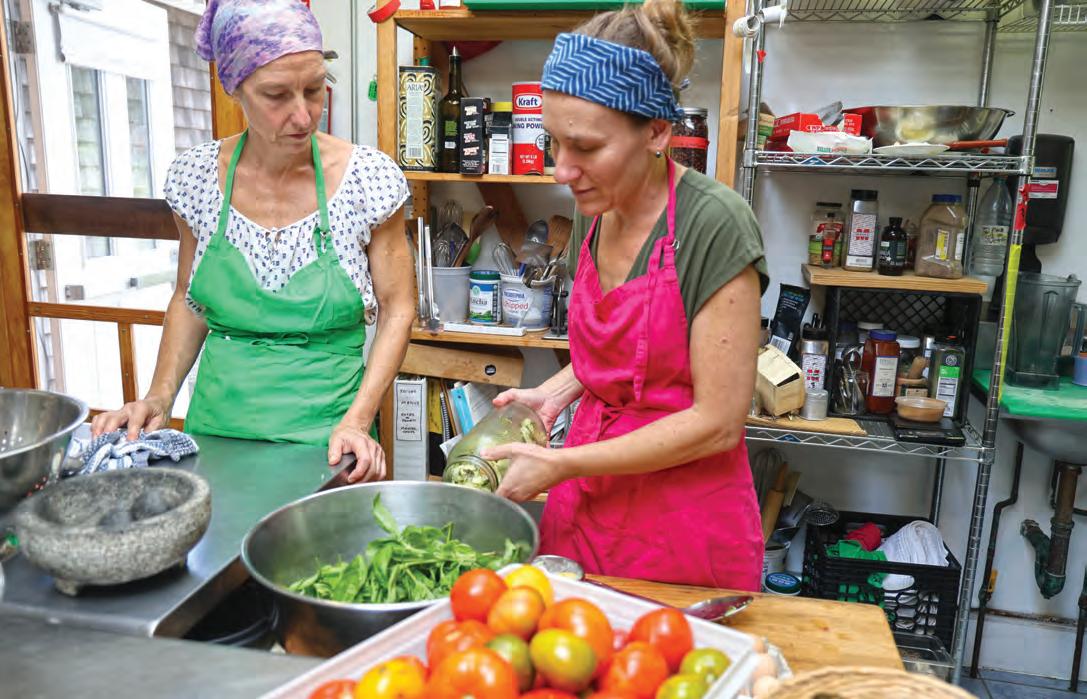
Betsy’s newest kitchen addition includes using recycled glass jars. “I ditched the jelly jars and started using things like salsa and
pickle jars to work with and serve food in. These are truly reclaimed, going from one use to another, and can be reused endlessly.” She also continues to refine her sourcing. She only offers things like oranges from out of state in the winter months, and uses Bragg apple cider vinegar instead of lemons. “Unless Cronig’s gives me a bunch,” she laughs. “I love when they call me and say, ‘I’ve got some good stuff for the kids.’ It just feels great. Or when IGI’s Astrid Tilton will call and say, ‘I”ve got wild spinach.’ The Chenopodium album is actually higher in iron. And I can tell the kids this and say, ‘Astrid picked this for us. It is called goosefoot.’ And it is all so intriguing and exciting that they make the choice to take a bite.”
FEATURE School lunch from scratch
She is just bringing thirsty people water, doing her part. She has changed my little kids’ lives.
44 edible VINEYARD
– kindergarten teacher Lori DiGiacomo
A bowl of fresh basil ready to be turned into pesto using the mortar and pestle.
My husband and I weren’t surprised when our younger son, Emmett, decided to plan a trip to Europe last fall. He’d been working all summer at his land surveying job, trekking through Island terrain in all kinds of weather, only spending money on take-out burgers and pizza, and the occasional new accessory for playing disc golf with his friends. He was ready for a change of scenery and cuisine. Always independent, with a confidence bordering on arrogance, Emmett was a natural adventurer. He’d been helping navigate highways and backroads since the days of Travel Little League, choosing restaurants and sights to see on family vacations. He was fully prepared and we were excited for him.
Much to our surprise, he called halfway through his European adventure to tell us he was sick. He’d been barfing his way from Oktoberfest to the Eiffel Tower and the canals of Amsterdam. He’d tried to tough it out, but between language barriers and foreign foods, he couldn’t find anything his system could tolerate, let alone enjoy eating. We all decided it was time to come home and figure out what was going on.
As an Island kid who spends much of his work and leisure time outside, Emmett was fairly certain the culprit was alpha-gal syndrome (AGS), an allergy triggered by a bite from the lone star tick. We had been hearing about AGS for a few years, as the lone star ticks started to populate the Island. I’m not much of a red meat eater, so I hadn’t given it much thought, but once a blood test confirmed that my baby was affected, I ran to the internet and researched with the obsessive dedication of a worried mother.

will. It is unclear why most people encounter alpha-gal when eating meat their whole carnivorous lives with no problems, but this specific method of exposure to the sugar can trigger an allergy not only to the meat of mammals but to other products, like dairy and gelatin. Reactions vary in intensity — from hives to vomiting to anaphylaxis, and don’t start for hours after exposure, much longer than most other food allergies.
For all of these reasons, diagnosis can be extremely difficult, particularly for people who live in areas where the allergy is uncommon. Emmett was lucky to have some knowledge of AGS before he got sick, and to have a doctor who recognized the signs right away and knew which blood test to order
Even still, food allergies are frustrating to live with, so much label-reading and explaining your quirky immune system. It can be isolating, too, especially for someone who loves sharing meals with other people.
The Island’s newest star
But Emmett approached this new challenge with his usual optimism and swagger. He gave us unsolicited reviews of new foods. Non-dairy “butter” tastes fine, but makes one wonder how they make vegetable oil a solid like that. Vegan cheese is abhorrently bland on its own, yet magically develops a cheese-like tang when added to another food. Emu and duck meat apparently taste like they are trying too hard to be something they aren’t. He didn’t miss red meat. Maybe because the memory of the sickness it caused was fresh in his mind, and maybe because he was back at home with his parents, who were spoiling him with sushi and salmon and roasted chicken dinners to ease the pain.
Unfortunately, all that googling turned up as many questions as answers; we don’t understand AGS all that well. Alpha-gal (galactose- a -1,3-galactose) is a sugar found in non-primate mammals — not just the meat, but also other products derived from it. It has been found in the saliva of certain ticks — the lone star being one of them — and is known to be transmitted in their bites, and can sometimes cause an allergy to alpha-gal in the bitten individual. But not always. Some people develop AGS after one bite, some after many, and some never
Sure, he’s more careful now, both about what he eats and about avoiding ticks. He seems to be one of the lucky ones whose allergy is disappearing with time. But a new bite might bring it all back. He still works outside, and spends much of his leisure time in nature. Instead of squashing his spirit, the experience has taught him some valuable lessons about paying attention to what he’s eating, and how it makes him feel. That headstrong attitude of his helped him make small adjustments so his life wasn’t affected all that much. With a little preparation, and some permethrin-treated clothing, the world is still his oyster — sweet and juicy and alpha-gal free.
Lone star ticks and alpha-gal syndrome comes a little too close to home.
WORDS Kate Athearn IMAGE Kristófer Rabasca
harvest season 2023 45 ON THE FARM
Raised With Care®
Raised With Care
Raised With Care
All natural pork, beef and lamb raised sustainably and humanely by a community of more than 600 independent family farmers and ranchers to produce the highest quality meat.
All natural pork, beef and lamb raised sustainably and humanely by a community of more than 600 independent family farmers and ranchers to produce the highest quality meat.
All natural pork, beef and lamb raised sustainably and humanely by a community of more than 600 independent family farmers and ranchers to produce the highest quality meat.



100% Certified Humane ®
No antibiotics or added hormones—EVER
Raised outdoors and in deeply bedded pens
100% Certified Humane ®
100% vegetarian feeds
No crates—EVER
100% Certified Humane ®
No antibiotics or added hormones—EVER
100% Certified Humane ®

Raised outdoors and in deeply bedded pens
No antibiotics or added hormones—EVER
No crates—EVER
No antibiotics or added hormones—EVER
100% vegetarian feeds
No crates—EVER
Raised outdoors and in deeply bedded pens
No crates—EVER
100% vegetarian feeds
Raised outdoors and in deeply bedded pens
Raised outdoors and in deeply bedded pens
100% vegetarian feeds
100% vegetarian feeds
®
®

DONE!
Steve Bernier isn’t retiring just yet
handshake deal Steve made with Robbie Cronig back in 1985 when he acquired Cronig’s Markets, he and Andrea agreed to terms in the fall of 2021, and together with the crew at Cronig’s, have not missed a beat.
Andrea is now at the helm of three stores and in charge of dozens of employees. We chatted with Steve to see how things were going now, a couple of years after the deal went down.
“I didn’t do this to retire right now,” Steve says. “She needs me as I need her. We created an equation that we didn’t know about until we had to actualize things. I did not want to sell to somebody who was going to kick me out of here and send me to retire.”
Lucky for Steve, Andrea is open to keeping him in the loop.
“It’s been kind of special, unique. Divine intervention,” he says.
Af ter 37 years, Steve Bernier sold Cronig’s Markets and Healthy Additions to longtime employee and Islander Andrea Donnelly, but he wonders why everyone keeps asking when he will finally retire.
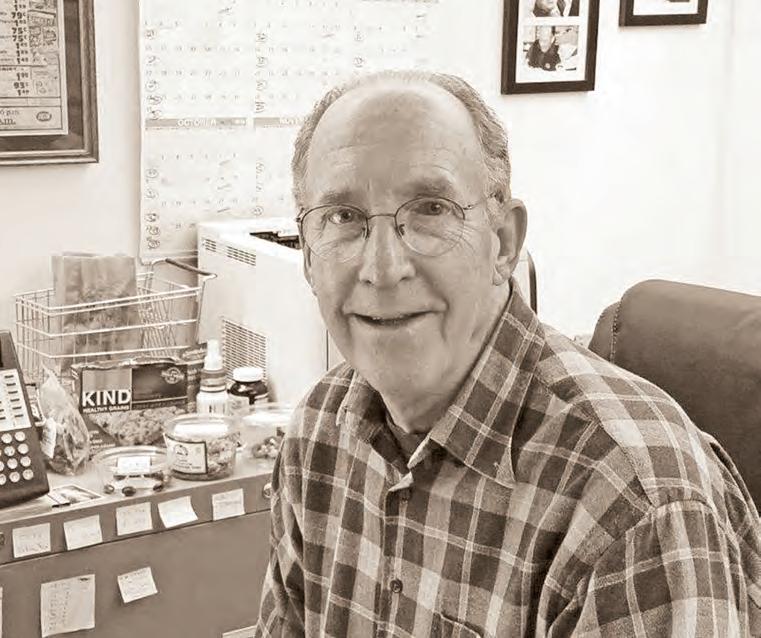
“She is working me 70 hours a week,” Steve says when Edible Vineyard asks how it’s going.
“By choice,” Andrea chimes in and laughs.
If you know Cronig’s you know Steve Bernier. You see him starting his day deadheading and taking care of the plants surrounding the stores or maybe sweeping up outside. He has worked tirelessly to build and maintain an Island institution. Like the
One of the first things that happened after Andrea took charge was the refrigeration in the down-Island store failing. It was a baptism by fire for Andrea, and she had a reality check right off the bat.
“We went through this year and we’ve watched the real world unfold, starting with day one with the refrigeration failure, and coordinating all this stuff with everything you can imagine happening,” Steve says.
As fate would have it, history repeated itself when Andrea and Steve set up their deal. The same attorney who authorized that handshake back in 1985 just happened to walk into the store to say hello at the very time they were deciding how to work out the deal, so the Cronig’s legacy continues with another handshake.
48 edible VINEYARD
DONE!
Photo courtesy Steve Bernier


 Vineyard Haven 508-693-4457 • West Tisbury 508-693-2234
Vineyard Haven 508-693-7097
Vineyard Haven 508-693-4457 • West Tisbury 508-693-2234
Vineyard Haven 508-693-7097
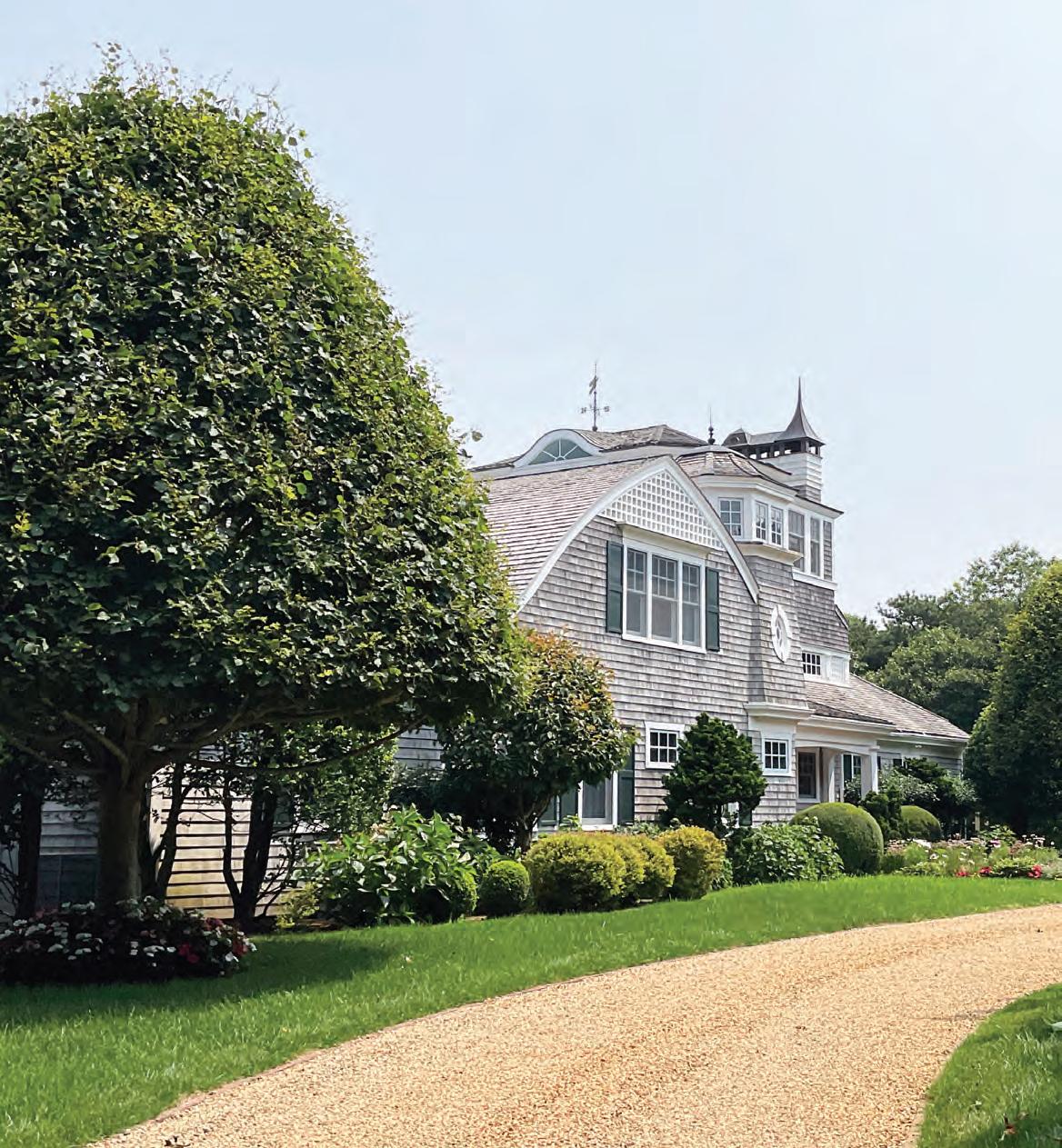
JWD Edible Sept AD 9-8.pdf 1 9/8/23 2:15 PM


























 By Maddy Alley
By Maddy Alley
































































 IMAGES Sadie Dix
IMAGES Sadie Dix













































 Vineyard Haven 508-693-4457 • West Tisbury 508-693-2234
Vineyard Haven 508-693-7097
Vineyard Haven 508-693-4457 • West Tisbury 508-693-2234
Vineyard Haven 508-693-7097
